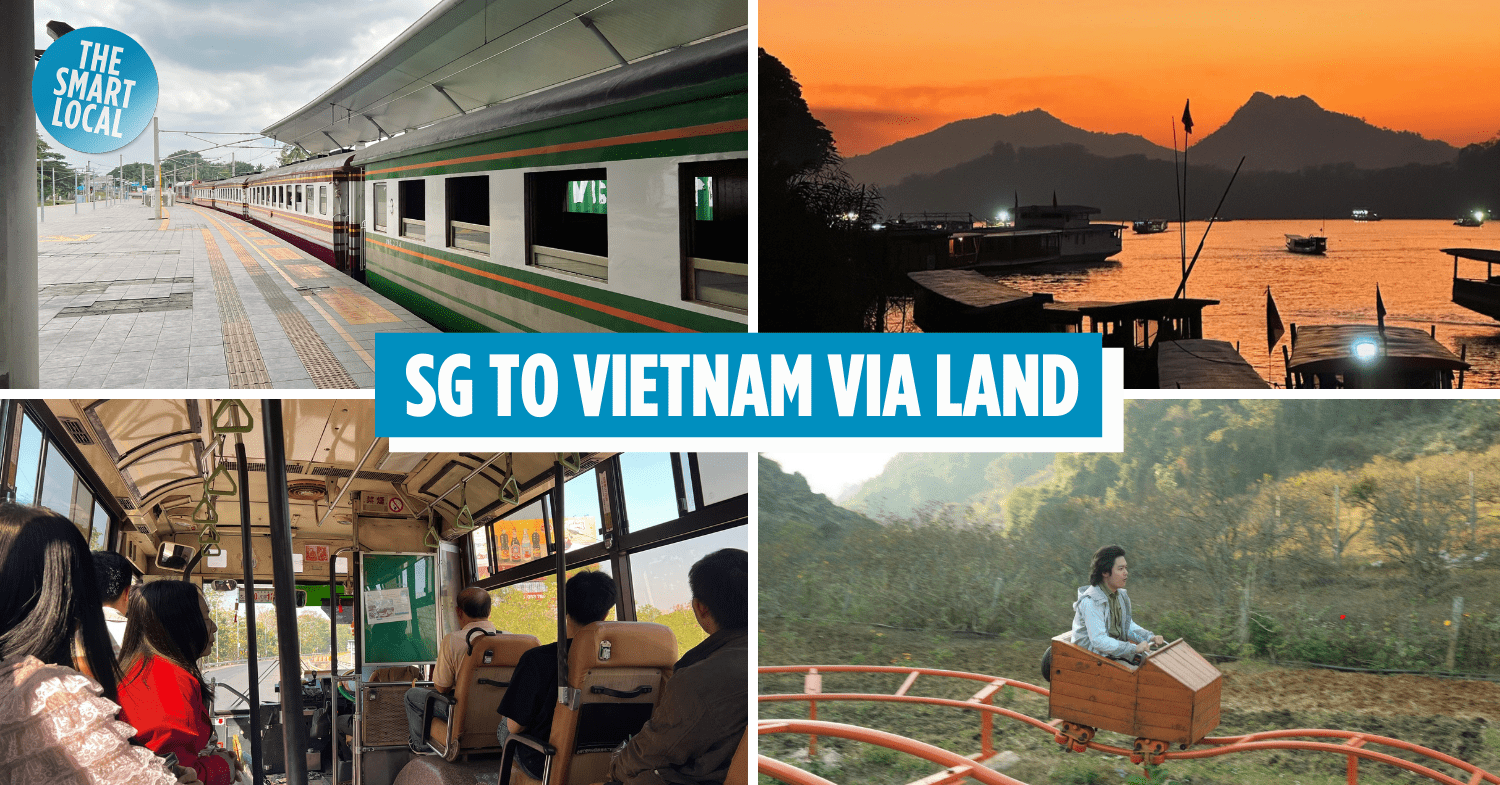Travelling overland from Singapore to Hanoi
As someone who’s from Hanoi but is currently living in Singapore, I’ve been on the 3.5-hour flight between the 2 cities countless times. Inspired by Southeast Asia’s increasing rail connectivity, visa-free agreements for ASEAN citizens, and a sense of adventure, I opted for a more unconventional way home during my most recent trip.
So in December 2024, my friends and I embarked on an adventure, travelling from Singapore to Hanoi over land in the span of 11 days. The 4 of us visited 5 countries and 12 cities, traversing over 3,500km along the way. Travelling over land and crossing land borders allows you to feel the distance you’re covering. Plus, I’m a firm believer in “It’s not about the destination, it’s about the journey”.
Table of Contents [hide]
- Travelling overland from Singapore to Hanoi
- Planning the land route before the trip
- Day 0: Singapore to Kuala Lumpur
- Day 1: Kuala Lumpur to Ipoh
- Day 2: Ipoh to Hat Yai via Padang Besar
- Day 3: Hat Yai to Bangkok
- Day 4: Nong Khai to Vientiane
- Day 5: Vientiane to Luang Prabang
- Day 6: Luang Prabang
- Day 7: Luang Prabang to Dien Bien Phu
- Day 8: Dien Bien Phu to Moc Chau
- Day 9: Moc Chau
- Day 10: Moc Chau to Hanoi
- Epilogue: Hanoi
- Frequently asked questions
Planning the land route before the trip
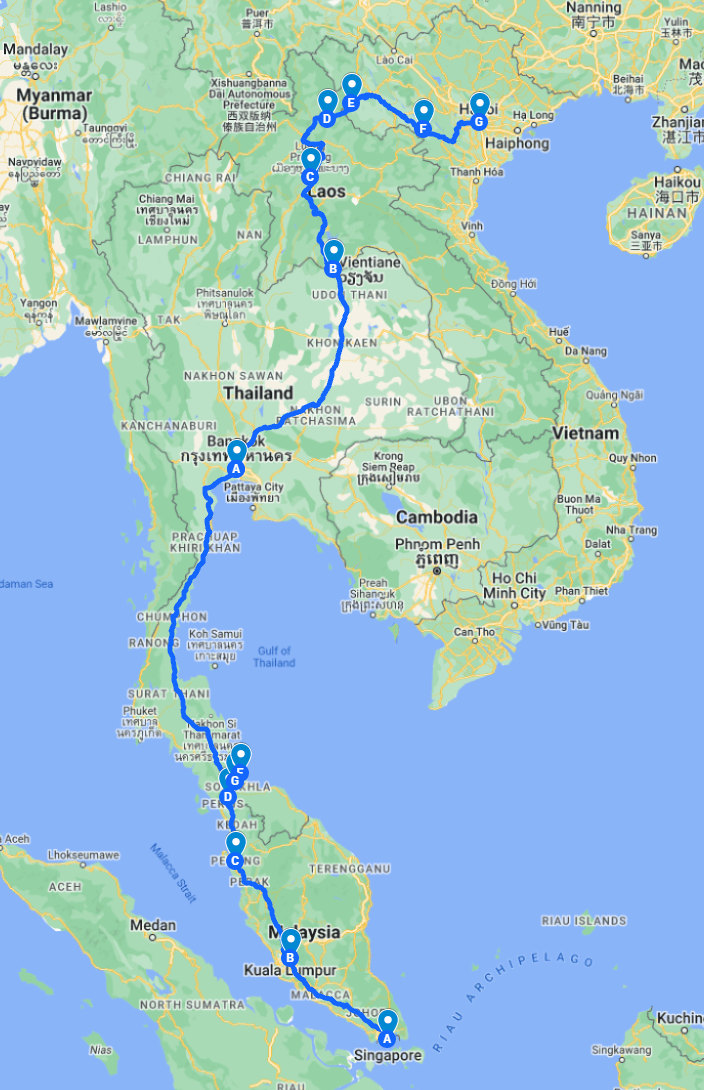
The overland route from Singapore to Hanoi.
Screenshot from: Google My Maps
The planning took about a month and most of the routes we took had plentiful research online. We supplemented any missing information with messages to travel agencies, posts in Facebook groups, advice from other friends, and trust that we could figure it out once we were there.
The total cost for all our one-way transport and budget-but-comfortable accommodations was about S$350 each, though this excluded the budget for food, souvenirs, and attractions. Most of the long-distance transport could be booked in advance, while some needed to be purchased in person—you’ve gotta be okay with winging it sometimes!
Day 0: Singapore to Kuala Lumpur
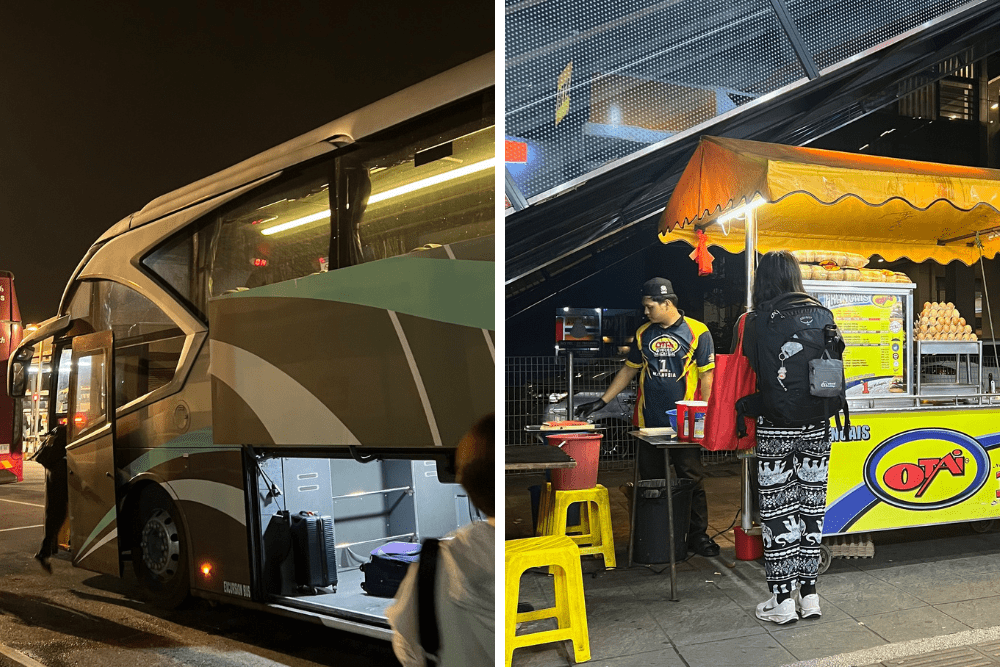
The first order of business after arriving was a roti john for supper.
Image adapted from: Billy Tran
As working adults with limited annual leave, we needed to maximise our time as much as possible. That meant starting the journey with a Friday night bus from Singapore to Kuala Lumpur. After a quick dinner at Bugis, we hopped on our bus at 7pm and reached our destination at 1am.
The ~S$38 bus journey took roughly 6 hours, including a good ol’ traffic jam en route. We booked our tickets via Easybook about a month in advance. Buses leave fairly frequently and there are a myriad of operators to choose from. While it is possible to go from Singapore to Kuala Lumpur by train, it would require 3 transfers and adherence to more inflexible train schedules, prompting us to take the direct bus option instead.
During the bus ride, we also decided to start an Instagram page @sea.over.land to document the odyssey.
Day 1: Kuala Lumpur to Ipoh
With only the morning in Kuala Lumpur, we had an early start to the day and tried to squeeze in a visit to at least one iconic site. Riding the handy monorail and LRT, we managed to see the Twin Towers, KLCC Park, and Petaling Street.
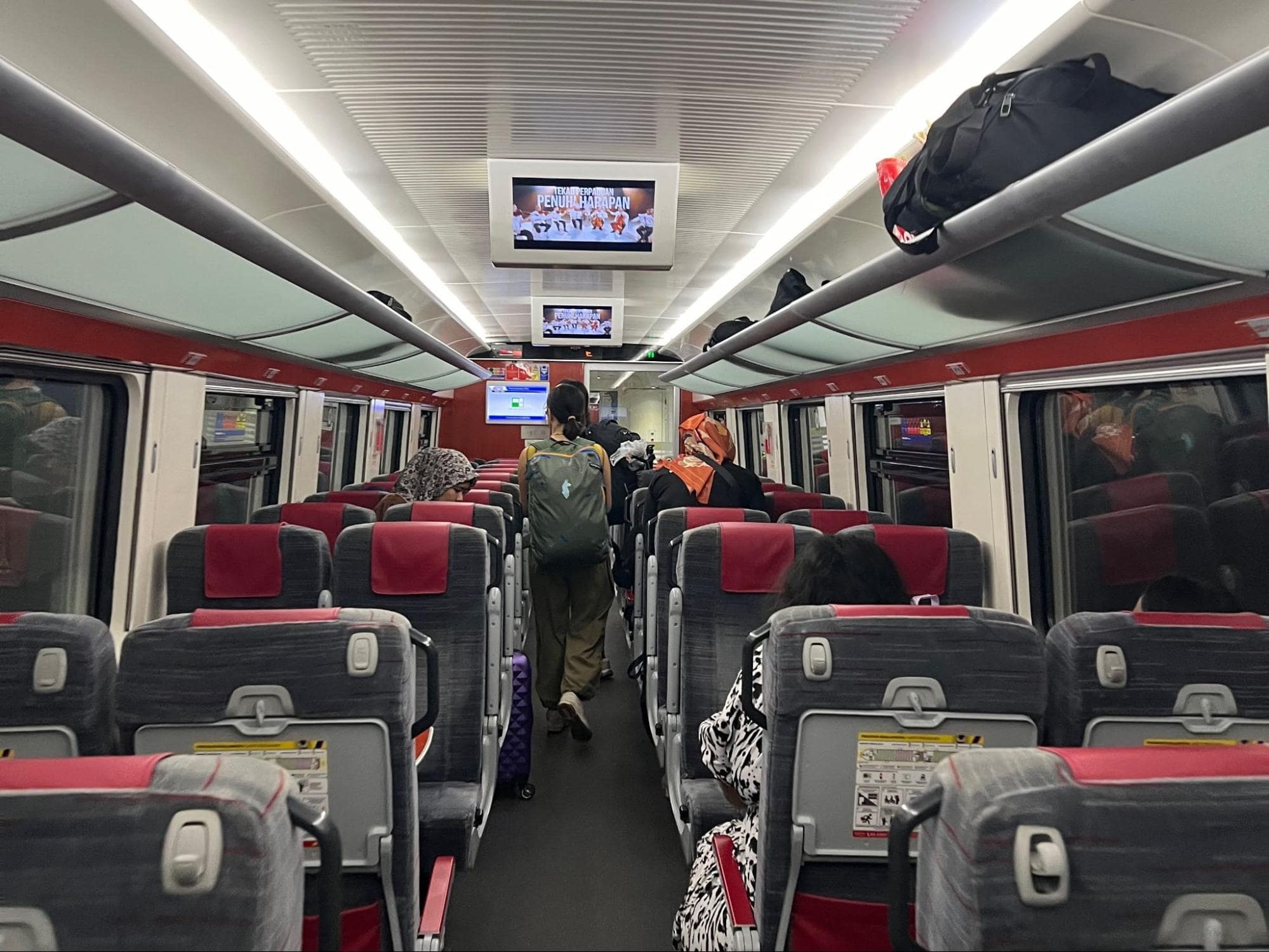
The 2-hour train to Ipoh.
Image credit: Billy Tran
We then checked out of our hotel, aptly called My Hotel @ KL Sentral, and walked over to KL Sentral at 12pm to take a 2-hour train to Ipoh. The ~S$15 train was modern, clean, air-conditioned, and even had a food carriage with light snacks and hot meals. Our tickets were booked directly on KTMB’s online website and it comes with fixed seats.
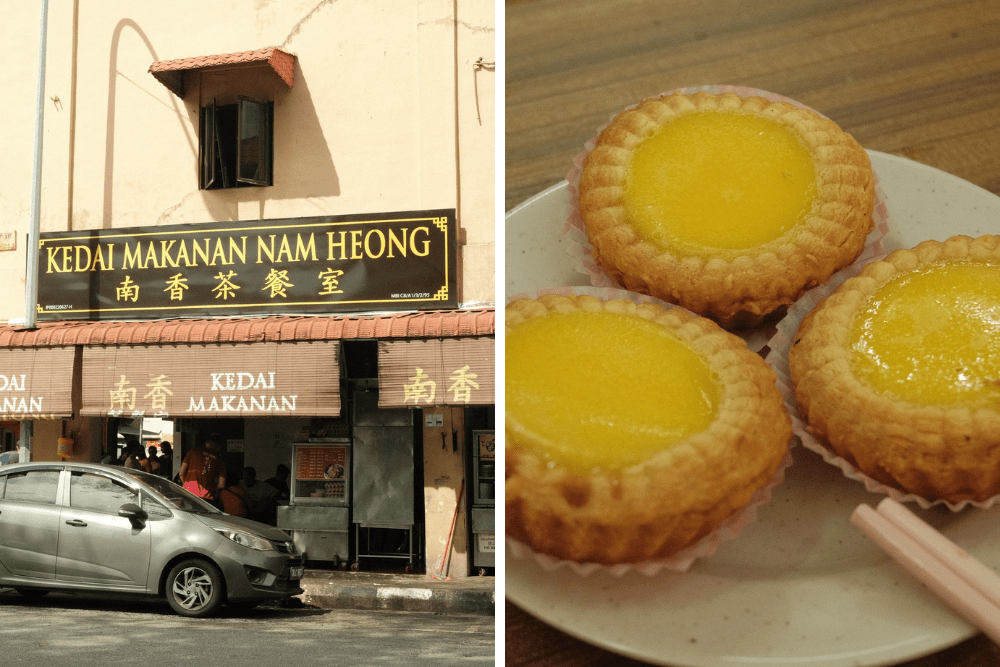
The name of the game in Ipoh was eat, eat, eat, and eat.
Image adapted from: Billy Tran
One member of our group used to live in Ipoh and thus we gratefully had access to her catalogue of food spots. Embarking on a non-stop food tour, we had dim sum and egg tarts at Kedai Makanan Nam Heong, chicken hor fun and flan at Restoran Thean Chun, nasi pandan at Ipoh Garden Gourmet Square, and an array of fruit including pomelos and bananas from roadside sellers.
Not only was it a gastronomic delight, but it was also heartwarming to see our friend reminisce about her favourite foods. Feeling completely stuffed, we took a quick stroll around the Ipoh Old Town before turning in for the night at the cosy Grayhaus Inn.
Day 2: Ipoh to Hat Yai via Padang Besar
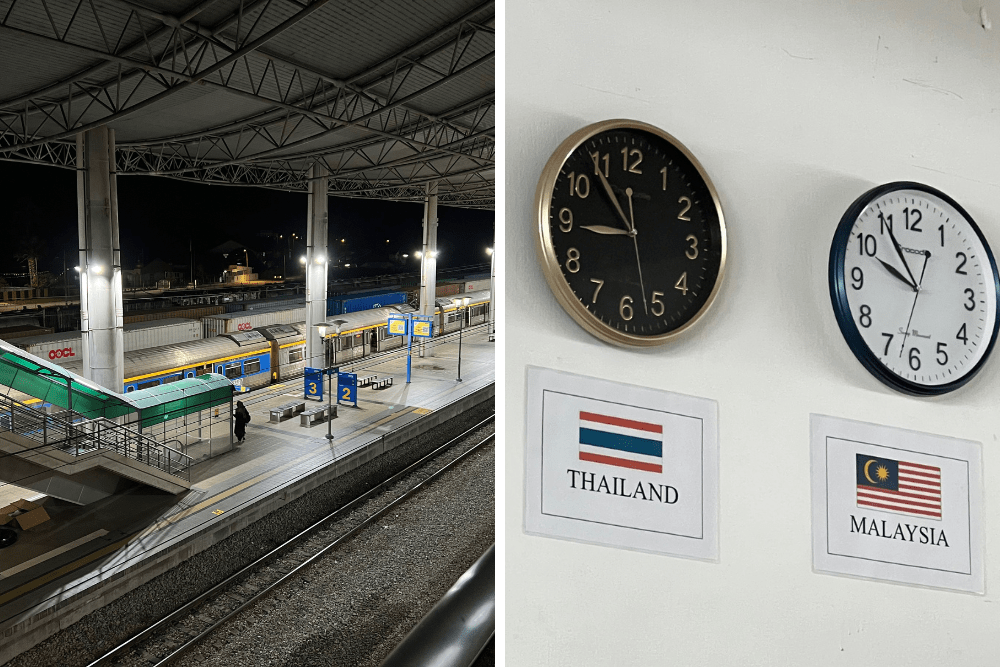
Thailand is one hour behind Malaysia. Once you cross the border, you’re essentially a time traveller!
Image adapted from: Billy Tran
The itinerary’s busiest travel day started at 5am as we took the first of 4 trains for the day. After a quick breakfast stop for more dim sum, we caught a 5.45am train departing for the Malaysia-Thailand border. The first step was a commuter train from Ipoh to Bukit Mertajam, followed by a connecting train from Bukit Mertajam to Padang Besar.
In total, this leg took 3 hours 41 minutes and cost ~S$7, with tickets available on the KTMB website on the day of travel or at the station itself.
As soon as we arrived, we headed to the ticket counter to purchase our cross-border train from Padang Besar to Hat Yai which cost ~S$2. The train takes 45 minutes, departing at 11.15am Malaysia time but arriving at 11am Thailand time. We took the morning train, but there were a couple more departures in the afternoon.
You’ll have to go through security and immigration where you’re stamped out of Malaysia and then into Thailand. It was fairly crowded during the weekend we were here, but it changes depending on your day of travel.
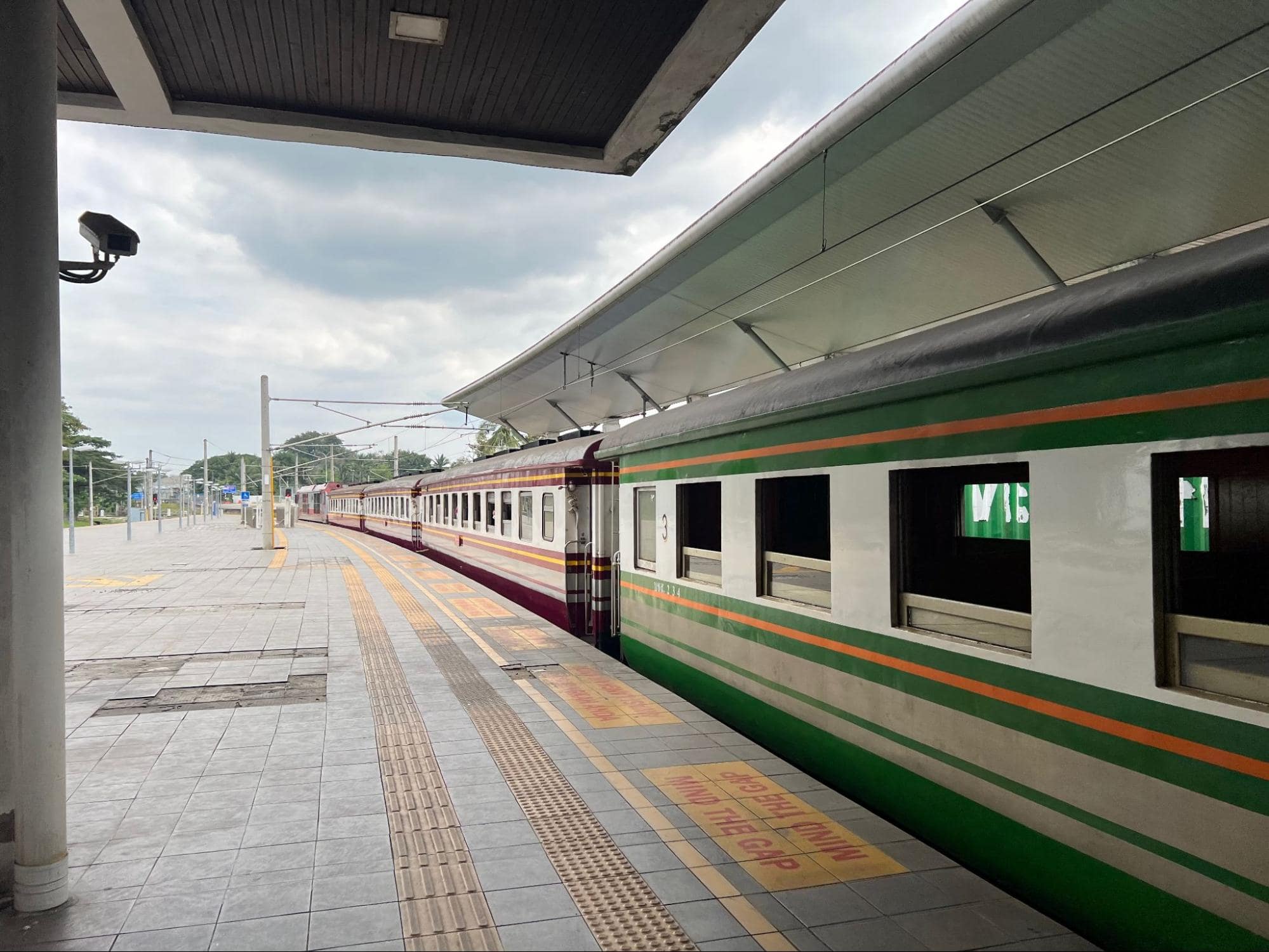
The charming train from Padang Besar to Hat Yai.
Image credit: Billy Tran
Pro tip: arrive early to purchase tickets as they can only be bought on the spot and can sell out fast during popular travel periods. Alternatively, there are frequent minivans that shuttle travellers between the 2 places. They should cost ~S$2-3 and take about an hour, roughly the same as the train.
A rustic train with large, open windows ferried us across small towns until we reached Hat Yai in Southern Thailand. Our schedule gave us 6 hours to explore the city, so, we first headed to Kai Tod Decha, a well-known joint serving fried chicken and other specialities.
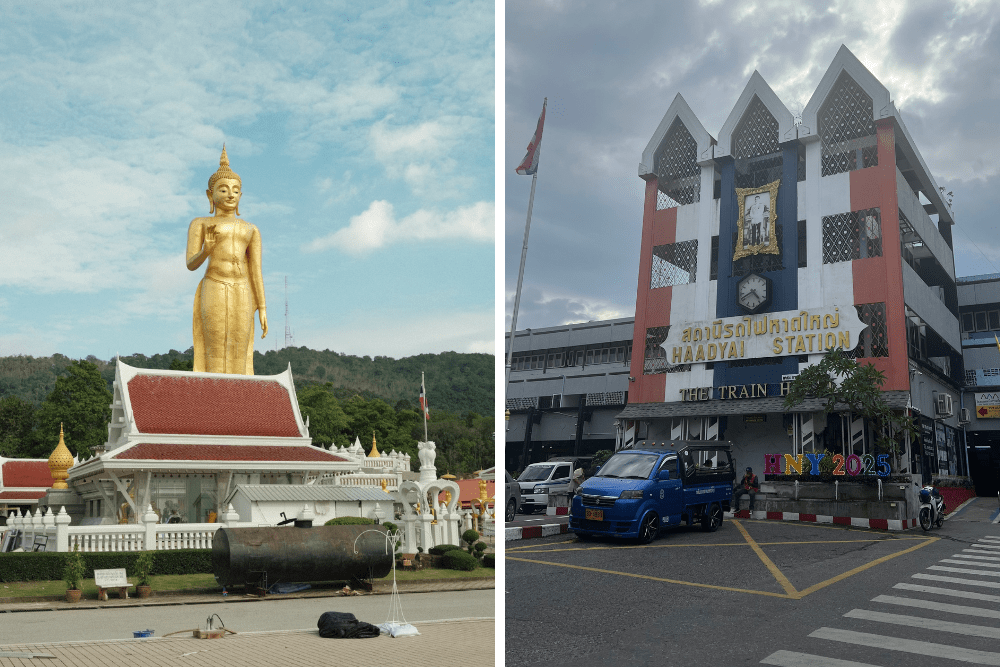
A towering golden Buddha statue atop Kho Hong Mountain (left) and Hat Yai Train Station (right).
Image adapted from: Billy Tran
We then explored the Hat Yai Clock Tower, Kim Yong Market, and Wat Chue Chang – all within walking distance of each other. My personal favourite has got to be Kho Hong Mountain which boasts a breathtaking panoramic view of the city and a gorgeous golden Buddha statue. Note that it’s slightly further out of the city, so plan your time accordingly.
Before long, it was time to head back to Hat Yai Station and board our 13-hour sleeper train to Bangkok, departing at 6.05pm. The price for a lower bunk sleeper berth was ~S$35.
Another pro tip: book online in advance from SRT’s website and get the lower bunks if possible since only those have windows for you to enjoy the view.
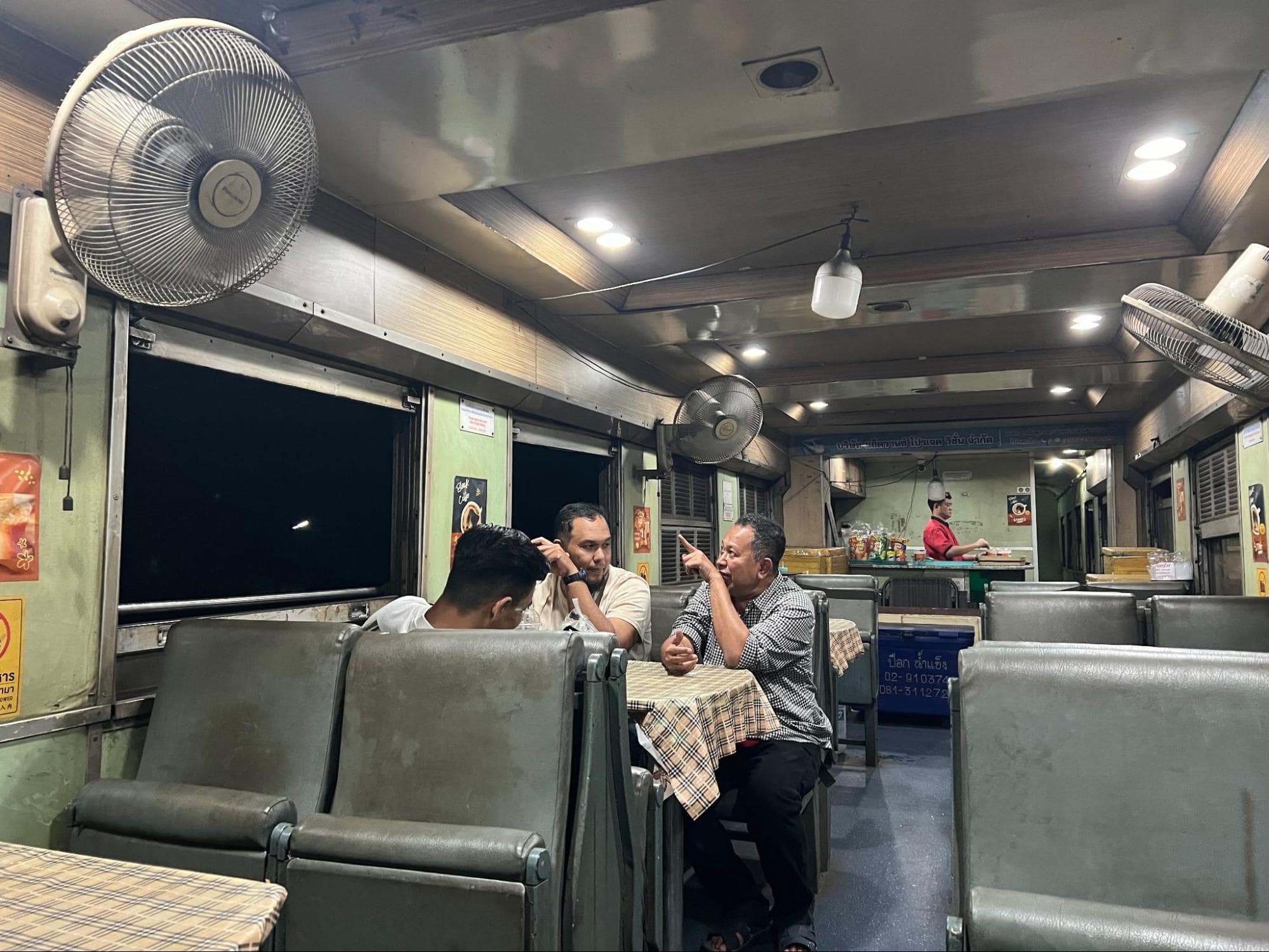
The train’s dining carriage is a nice place to unwind, but it is bumpy!
Image credit: Billy Tran
Shortly after departure, the train attendant converted our seats into beds for the night. As the sun set we reflected on 2 things. One, we had taken a whopping 4 long-distance trains on the same day. Second, how was it only day 2?
Day 3: Hat Yai to Bangkok
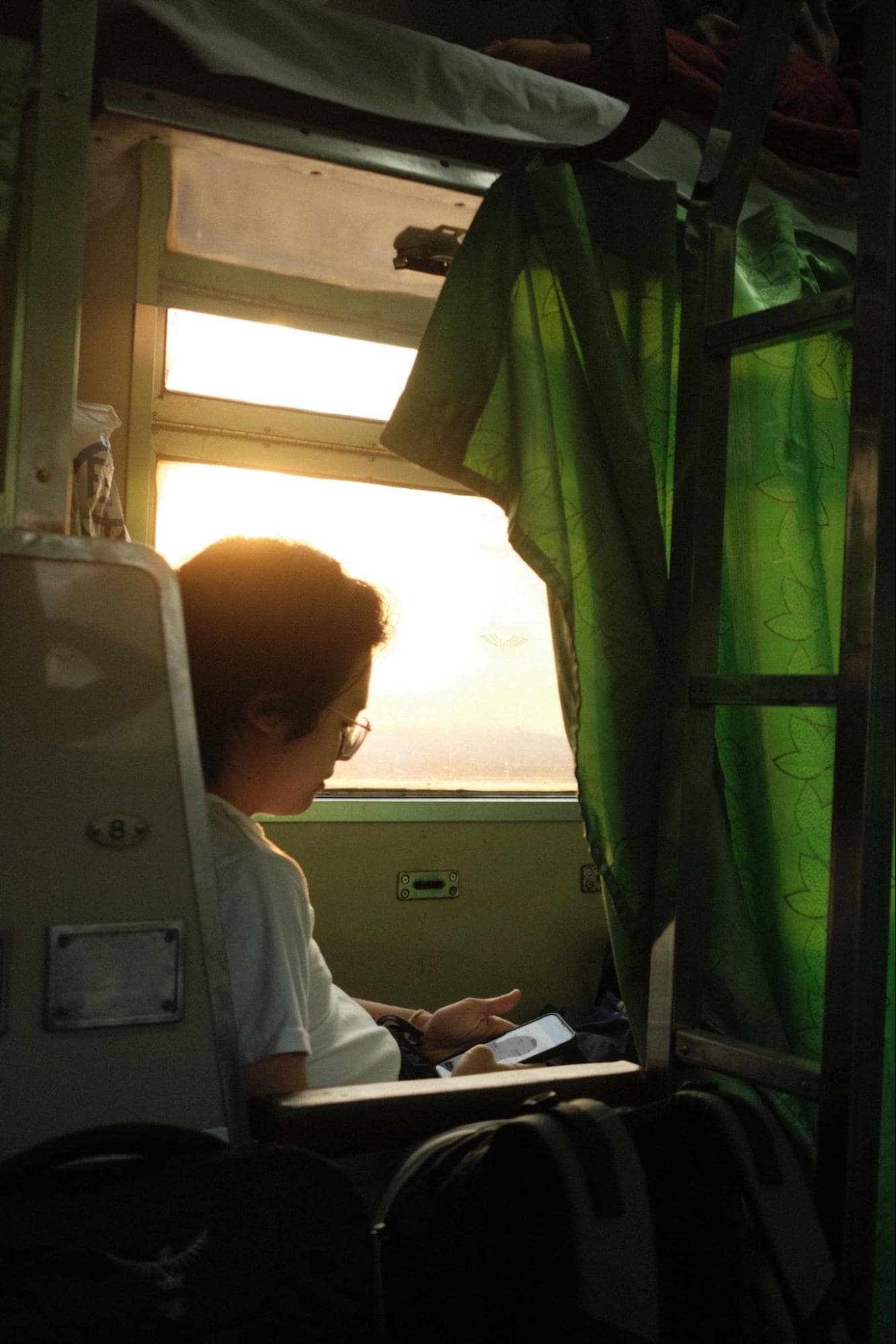
Sunrise on the sleeper train.
Image credit: Billy Tran
Sleep on the train was a lot more comfortable than one would expect, especially with the plush pillow and thick blanket provided. We arrived at Krung Thep Aphiwat Central Terminal in the bustling city of Bangkok at 9.05am. Storing our bags at luggage lockers in the station, we set out to enjoy our half-day layover in the city.
Though there are a lot of things to do in Bangkok, we decided to take it easy with a stroll around Chatuchak Park and some roadside coffee at a tiny cafe called Behind The Bar. The cafe chill time also allowed us to take a breather from the constant travel and review our plans for the rest of the journey.
To round up the standard Bangkok tourist routine, we ate street food, walked around a night market, visited a thrift shop, and got a well-deserved massage.
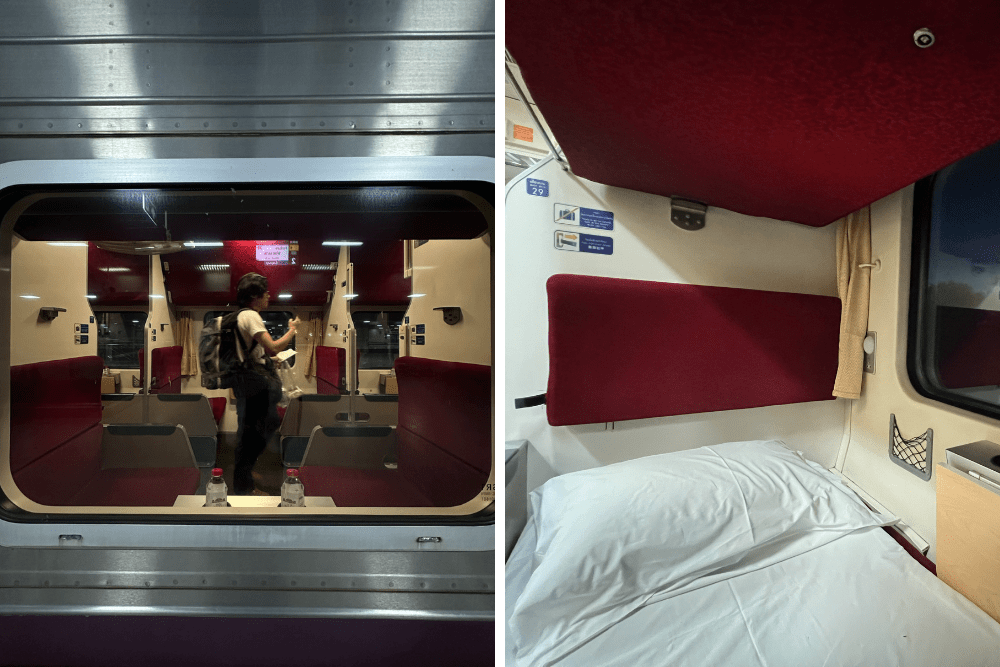
Image adapted from: Billy Tran
At 8.05pm we returned to Krung Thep Aphiwat Central Terminal, collected our bags, and boarded our second sleeper train in a row from Bangkok to Nong Khai. This train was newer and more modern-looking than our previous one. Just like last time, remember to book the lower berth to ensure you get a window view.
Dinner was courtesy of food vendors and convenience stores at the train station before boarding. We tucked into our ~S$38 lower bunk sleeper berth – also booked online with the State Railway of Thailand in advance – as the train departed the busy city. It had only been a few days but we were about to traverse the entirety of 2 countries. You’d cover the same distance by plane if you flew to your destination, but these trains really allowed us to feel that distance.
Day 4: Nong Khai to Vientiane
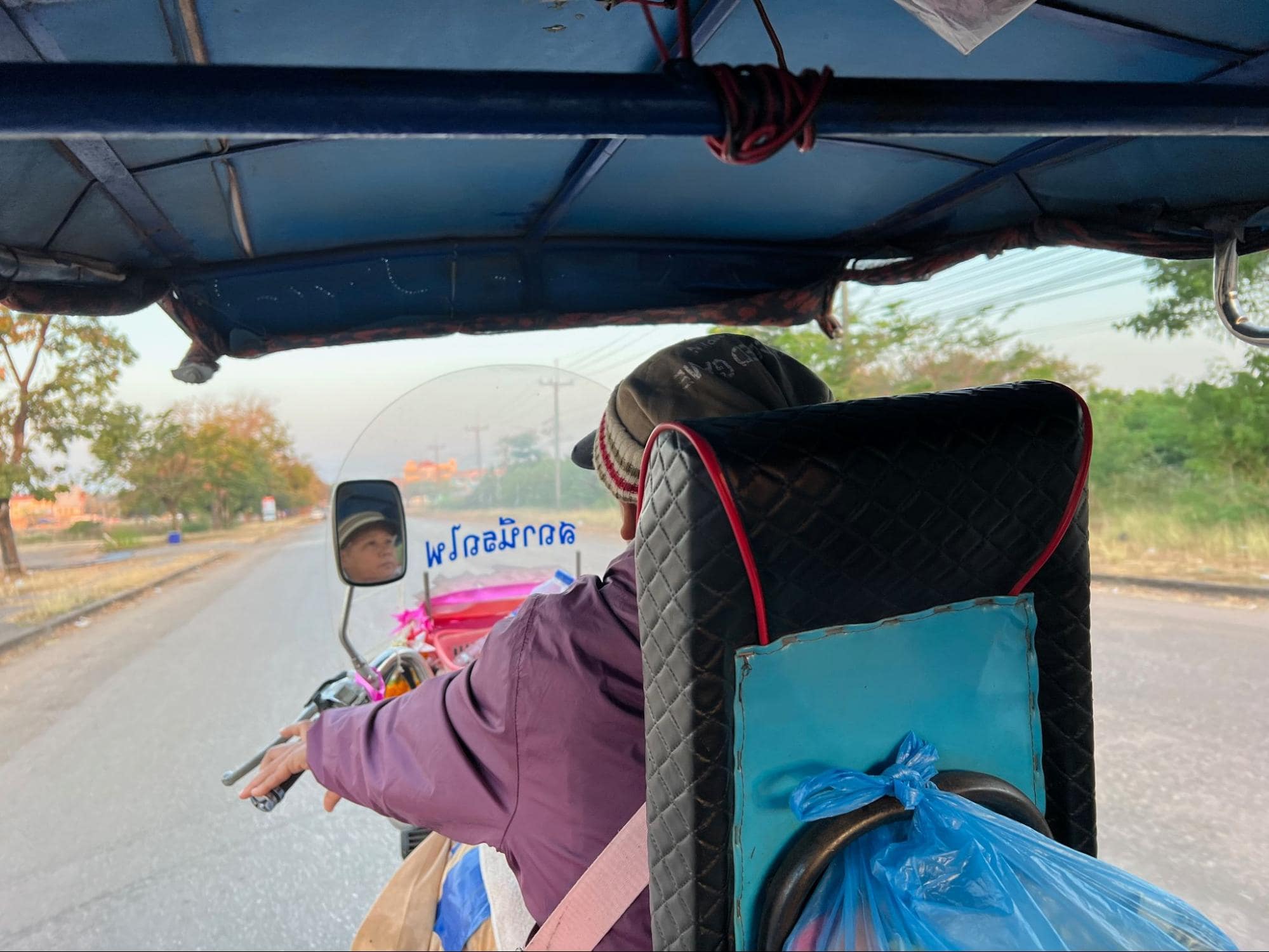
We asked a tuk-tuk driver to bring us around Nong Khai.
Image credit: Billy Tran
The train pulled into Nong Khai, a Northern Thai city bordering Laos, just after dawn at 6.25am and we soaked in the gentle, soft sun. Though we planned to take an 8.35am train from Nong Khai to Vientiane across the border, some hiccups arose since our friend who held a Myanmar passport wasn’t allowed to cross via land at that time.
There was no way we were going to leave our friend behind, so we put our problem-solving hats on. We managed to figure out a way for her to fly into Vientiane and meet us there. While we waited to enact the plan, we had a little more time to kill in Nong Khai.

The Mekong River demarcates the border between Thailand and Laos in this region.
Image credit: Billy Tran
Our tuk-tuk driver dropped us off at a riverside boardwalk with stunning views of the Mekong River. The third-longest river in Asia, the Mekong runs through 5 countries and has been the cradle of various Asian civilisations for centuries. A quick visit to Wat Hai Sok – a nearby Buddhist temple – and The Rail Market – a former railway station turned museum—rounded up our exploration.
Honestly, we could’ve spent the entire day admiring the Mekong’s beauty if we wanted. But with the early morning breeze evaporating away, we took a Grab to the Thai-Lao Friendship Bridge border checkpoint where immigration was a breeze and we were stamped out of Thailand. Despite missing the morning train, there is a frequent ~S$2 bus to Laos that shuttles passengers across the river once you clear immigration, just like the Singapore-JB Causeway.
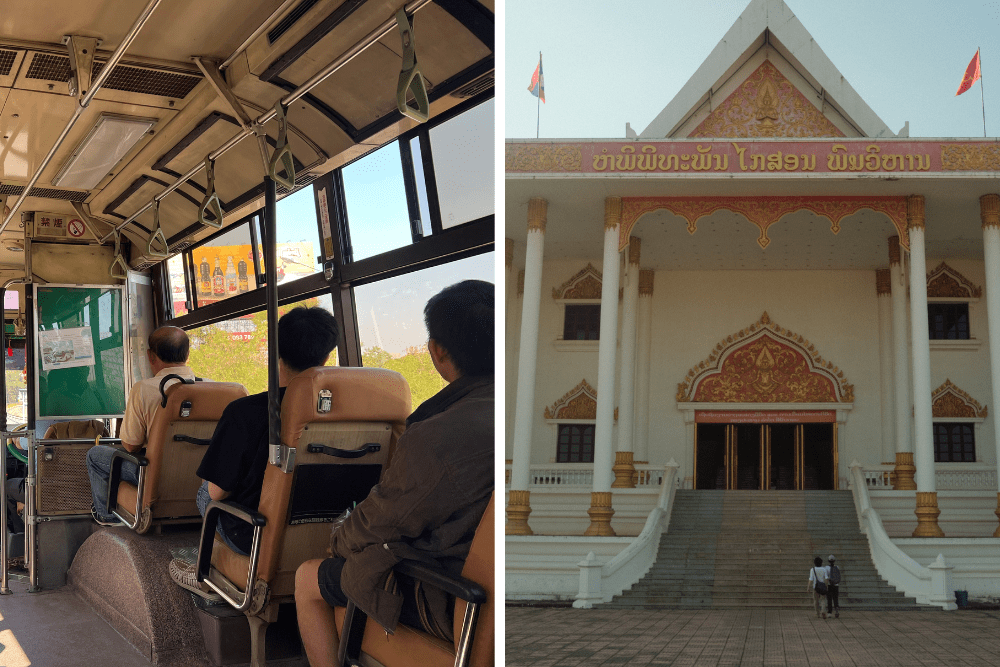
On the bus crossing the Thai-Lao Friendship Bridge.
Image adapted from: Billy Tran
On the other side, you’ll have to fill in an immigration form and pay a small fee of 20 baht (~S$1) which you can pay in Thai baht. Note that Laotian kip is a closed currency not readily available outside of Laos, so bring some extra cash to exchange. However, most places in the country accept baht or USD as well.
Vientiane is a 30-minute taxi ride from the Thailand-Laos border and there are plenty of drivers waiting to pick you up. Our first stops were the Lao National Museum and the Kaysone Phomvihane Museum, conveniently located right next to one another. We found the latter more interesting, especially since the former was still under renovation during our visit.
To get around Vientiane, you can download Loca (App Store | Google Play), Laos’ equivalent of Grab. Alternatively, you can rent a motorbike or car.
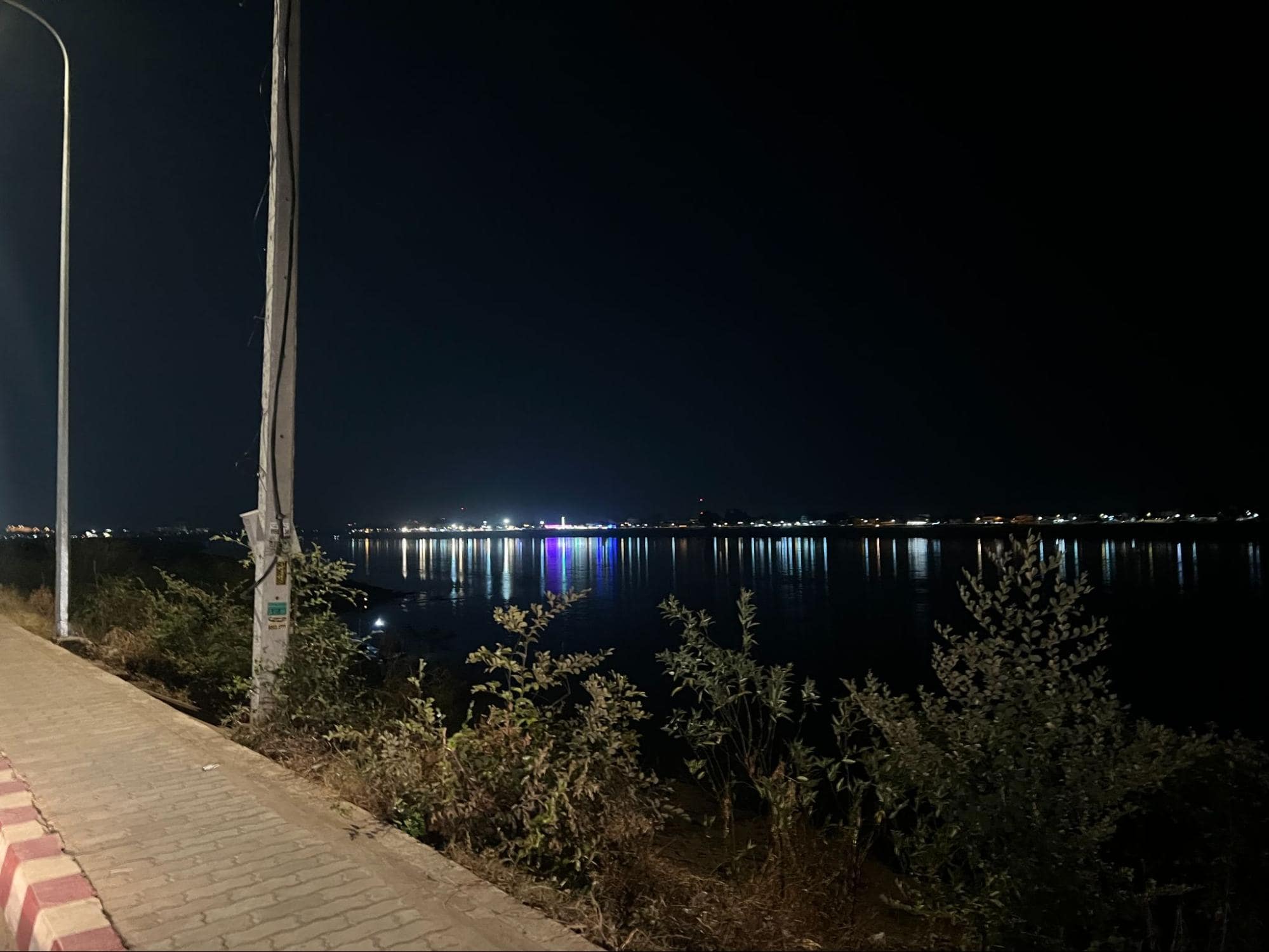
Ending the night along the Mekong River in Vientiane, Laos.
Image credit: Billy Tran
As dusk approached we found our way back to the Mekong, albeit on the other side this time. The riverside area was bustling with activity including a night market, various street food vendors, and even a mini-amusement park. We also reunited with our friend who flew in!
Day 5: Vientiane to Luang Prabang
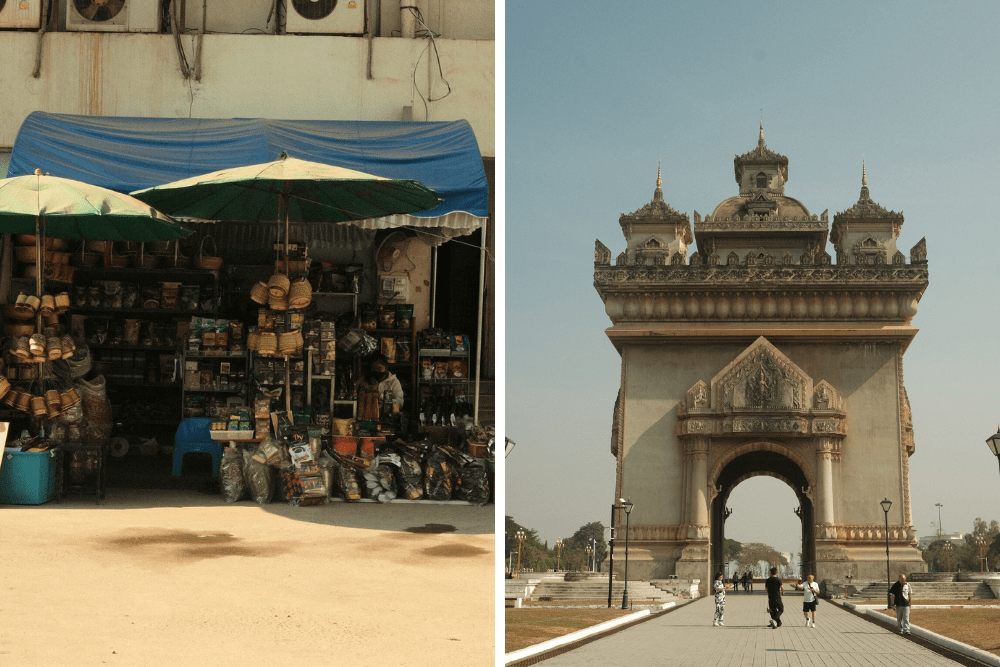
Image adapted from: Billy Tran
Day 5 started with a visit to Talat Sao Morning Market, a huge all-in-one shopping complex. The indoor section had a myriad of goods such as clothes, electronics, and souvenirs while the outdoor section had a variety of foods.
After having breakfast at the market, we headed over to Patuxai Victory Monument, a memorial dedicated to those who fought for Laotian independence from the French. You can also pay a small entrance fee to go to the top of the monument.
Once we finished the morning exploration, we grabbed a Loca to drive us the 20-30 minutes to Vientiane Railway Station. Newly built and supported by Chinese funding, this station is the Southern terminus for the Laos-China Railway, a high-speed railway that runs through Laos and towards Kunming in China. The station itself was clean, modern, and equipped with amenities. It also required an airport-like security check before entry.
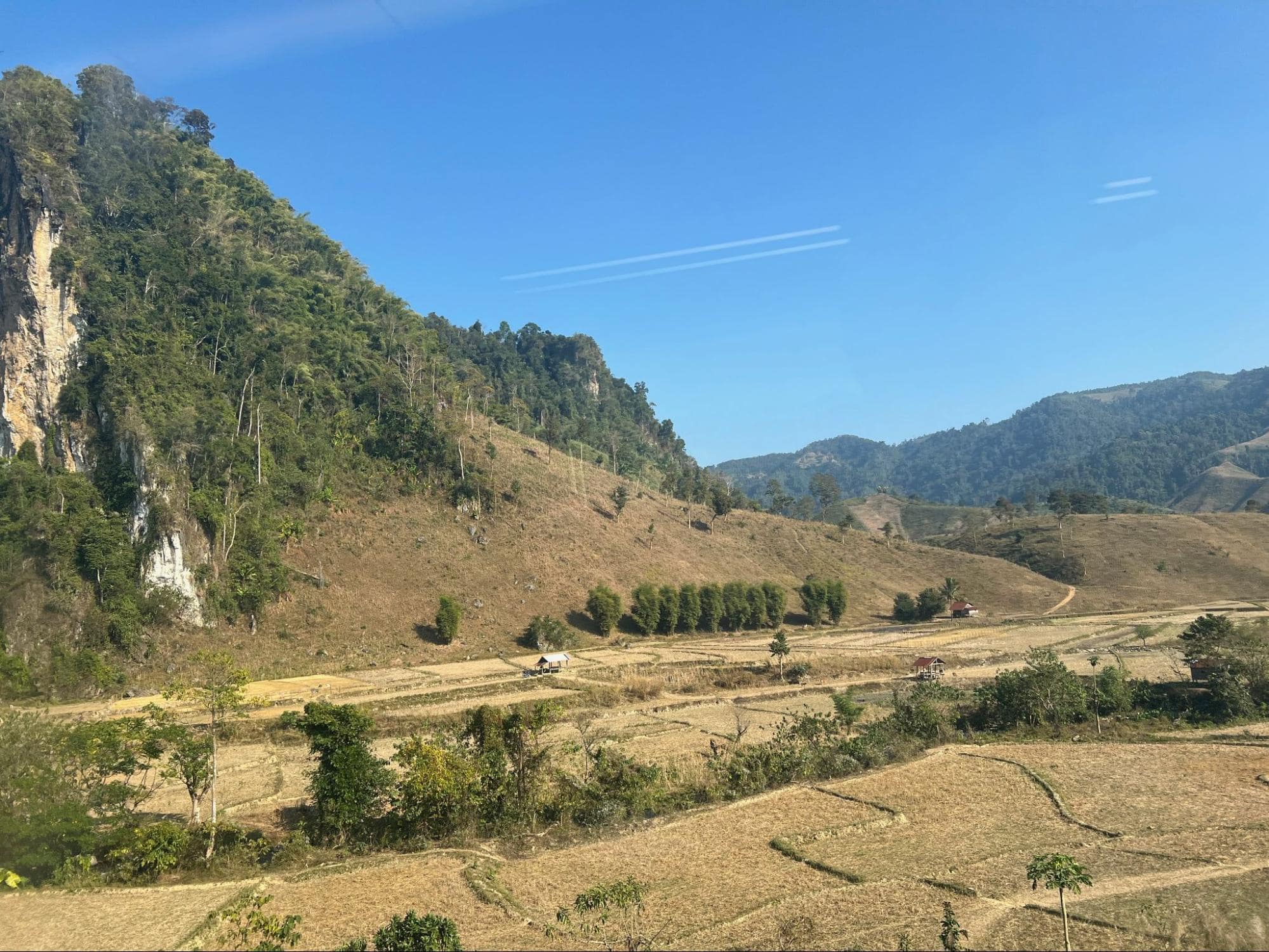
Train window views will never get old.
Image credit: Billy Tran
We paid ~S$26.80 for our 2-hour high-speed rail to Luang Prabang departing at 1.30pm. However, there are many ways to purchase tickets:
- The cheapest option, costing ~S$20.60, is booking directly via the “LCR Tickets” app. However, the app is finicky and requires a Laotian, Chinese, or Thai phone number to log in. Moreover, tickets will only go on sale 3 days before your departure date and may sell out fast.
- Various online third-party operators like 12go.asia will help you purchase tickets and charge an additional convenience fee of anywhere between S$5-$20. We chose this option and found one – Lao Booking Service – with a low fee.
- If you’re already in Laos, most travel agencies and hotels can also help you purchase tickets for a similar convenience fee.
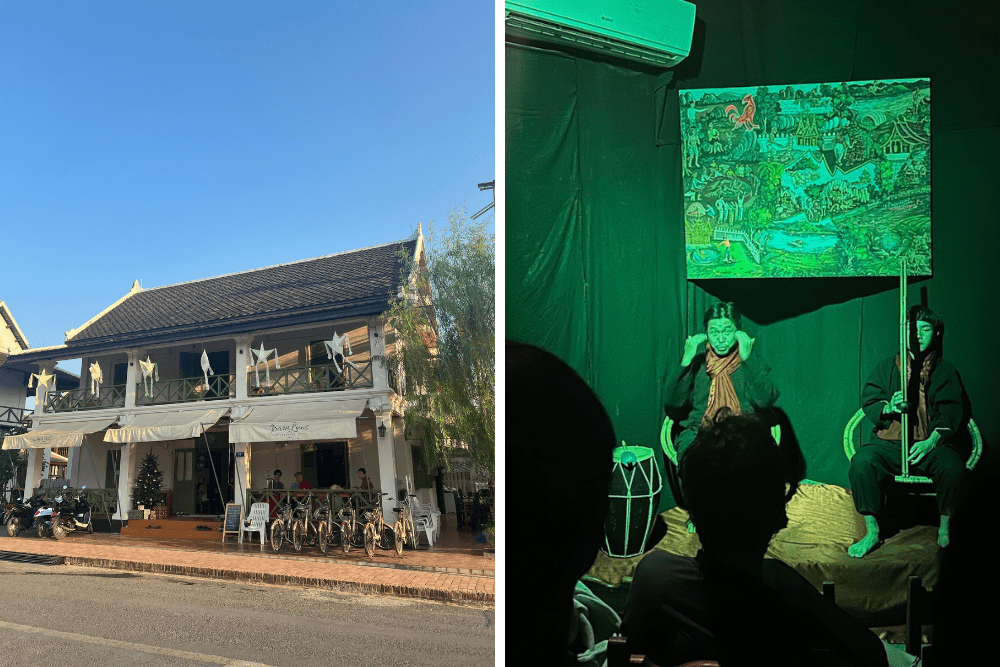
Our cosy hostel, Barn Laos Luang Prabang.
Image adapted from: Billy Tran
At 3.30pm we arrived at Luang Prabang, a designated UNESCO World Heritage site since 1995. The old town is adorned with charming buildings blending traditional Lao houses with colonial architecture. The city was also the royal capital of Laos for centuries and is where the Mekong and Nam Khan rivers meet.
We watched a show at Garavek Storytelling and listened to various Laotian folktales, legends, and myths. It was a great introduction to Luang Prabang, as hearing the vibrant stories associated with the surrounding Nam Khan River and Phousi Hill greatly enriched our experience when we visited them the next day.
Day 6: Luang Prabang
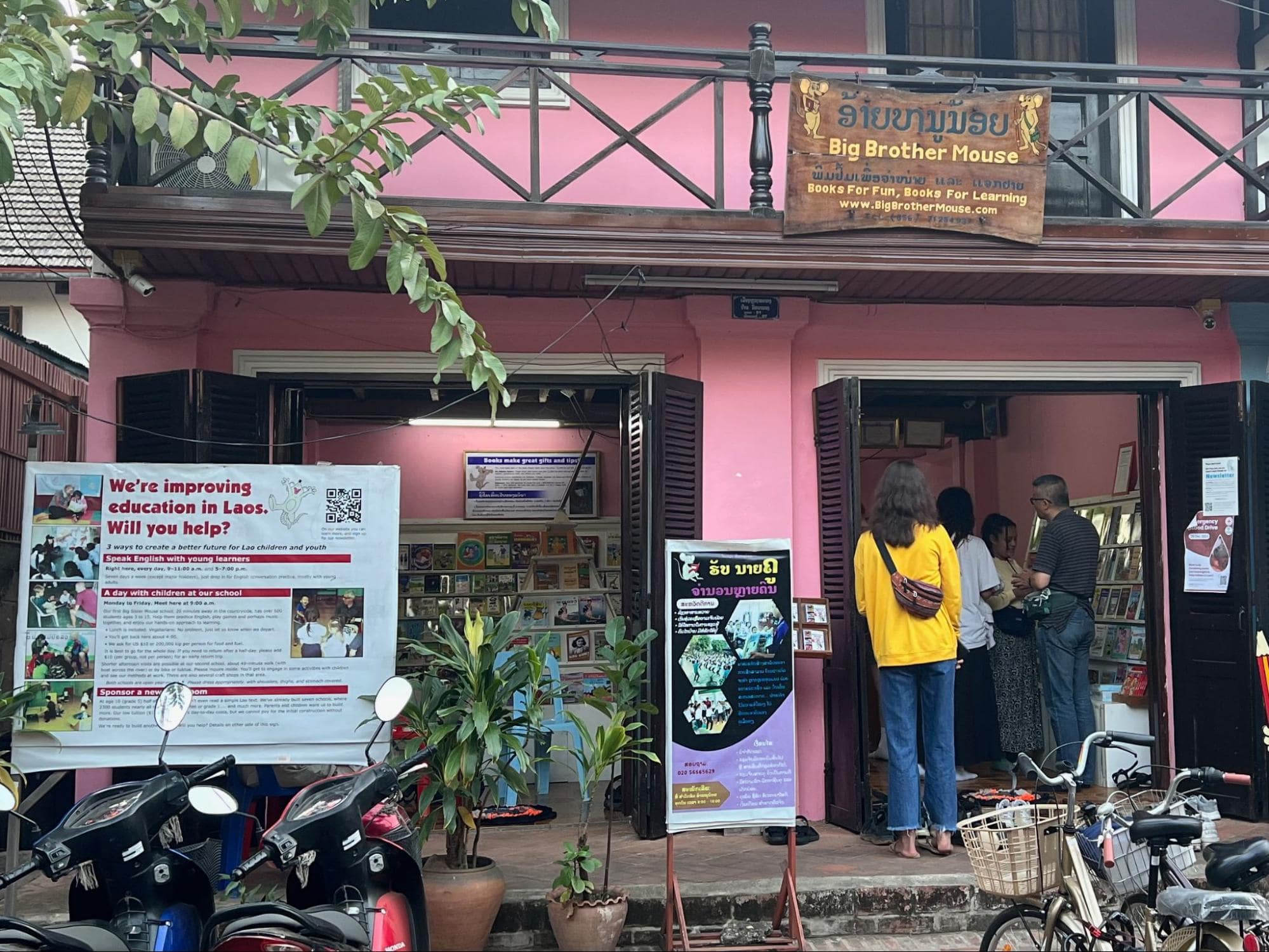
Big Brother Mouse in Luang Prabang.
Image credit: Billy Tran
For the first time on this trip, we were staying in the same city for more than 24 hours. Imagine our joy when we didn’t have to immediately pack our bags after just one night.
After a well-deserved slow morning, we headed to Big Brother Mouse, a non-profit educational centre and publishing house where tourists can drop in and help local students learn English via conversations. You can also learn more about their work to improve educational literacy in Laos.
Afterwards, we hailed a tuk-tuk to take us to the UXO Lao Visitor Centre, a small museum detailing the effects of unexploded bombs and mines. Laos is the most heavily bombed country per capita in the world, courtesy of American bombing campaigns during the Second Indochina War.
The exhibition sheds heartbreaking light on the present-day, continued effects of these unexploded bombs and the inspiring work of organisations aiming to clear them. We felt that it was important to understand and acknowledge the history of the places we were visiting.

The breathtaking Kuang Si Falls.
Image adapted from: Billy Tran
A trip to Luang Prabang wouldn’t be complete without visiting the famous Kuang Si Falls. The site’s about an hour’s drive from the city centre, and most travel agencies or hotels can help you arrange transport.
The multi-tiered waterfall was stunning—it’s one of those attractions that look ten times better in person than on camera. The surrounding national park was also extremely scenic. You could spend hours hiking the various trails and immersing yourself in the trees, as well as an equal amount of time with photo ops at every angle.
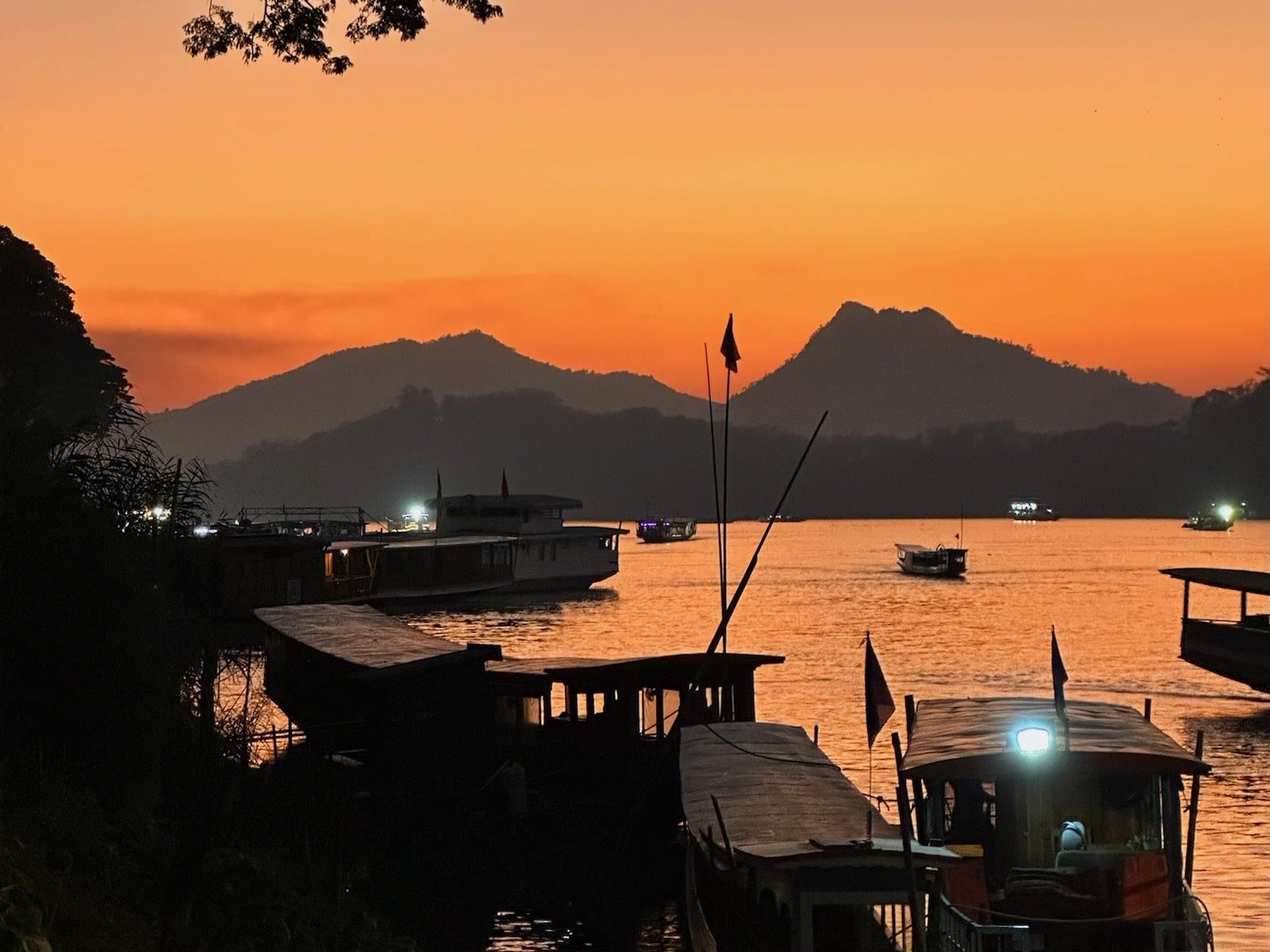
The picturesque sunset on the river.
Image credit: Billy Tran
Back in the city, you can book various river cruises to enjoy the sunset. We opted to just head down to the riverbank and enjoy the view there. The image of a Luang Prabang sunset by the river, a golden-orange mountainous backdrop with small boats shuttling by, is forever seared in my mind.
We ended the night by watching the first leg of the ASEAN Football Championship semi-final, fittingly contested between Vietnam and Singapore. The Vietnamese team won the match 2-0, and this football championship would be a recurring motif throughout the rest of our trip.
Day 7: Luang Prabang to Dien Bien Phu
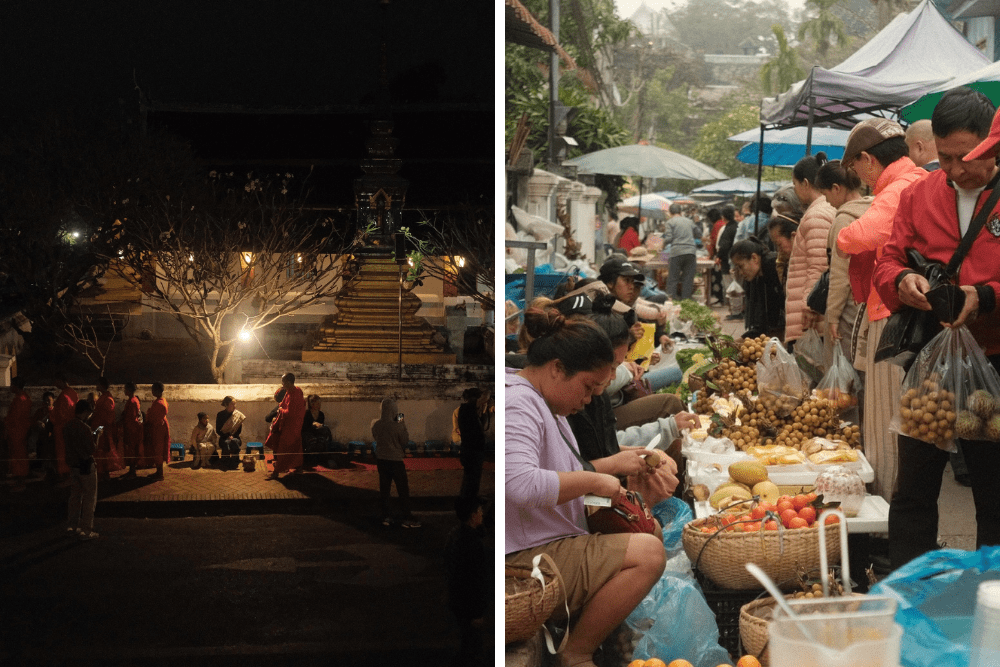
Image adapted from: Billy Tran
Waking up before dawn, we caught the alms giving ceremony from our hostel window. It’s a longstanding Buddhist ritual whereby monks accept food offerings as they walk along the main road.
Making use of the morning, we walked along the Luang Prabang morning market to stock up on fruits and snacks for the travel day ahead. We also said goodbye to the Mekong River, which had been by our side since day 4.
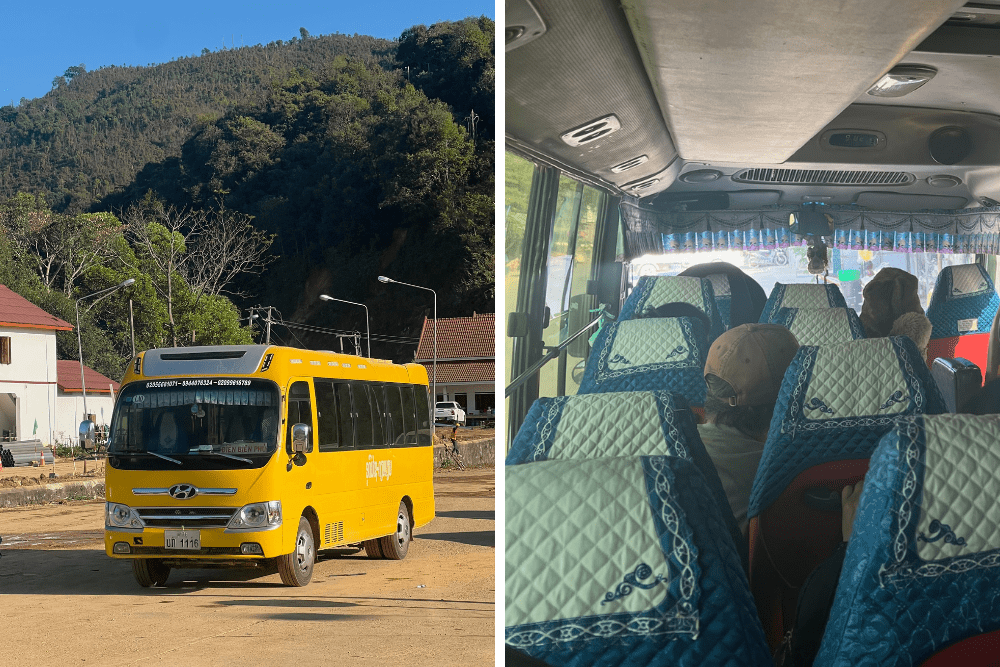
The trusty and rather adorable yellow bus that brought us through the mountains from Laos to Vietnam.
Image adapted from: Billy Tran
The journey from Laos to Vietnam was the trickiest to figure out, especially since there were no train routes between the 2 countries. The most common way involved sleeper buses from Vientiane or Luang Prabang to Hanoi, but these were particularly uninviting 20-hour journeys. Instead, we tried to get to Dien Bien Phu, a Vietnamese city near the Laotian border that would only take about 7 hours.
The leg from Luang Prabang to Dien Bien Phu came in 2 parts:
- First, we went back to the Luang Prabang Railway Station to take a 50-minute high-speed train to Muang Xai, departing at 9.57am and arriving at 10.41am. We used the same third-party operator and our tickets cost ~S$15.
- Step 2 was a 6-hour bus from Muang Xai to Dien Bien Phu. We found this bus via an extensive Facebook search and many online messages to individuals who left their contact cards. The bus left at approximately 11.30am and arrived in Dien Bien Phu at around 5.30pm, with tickets at ~S$20 each.
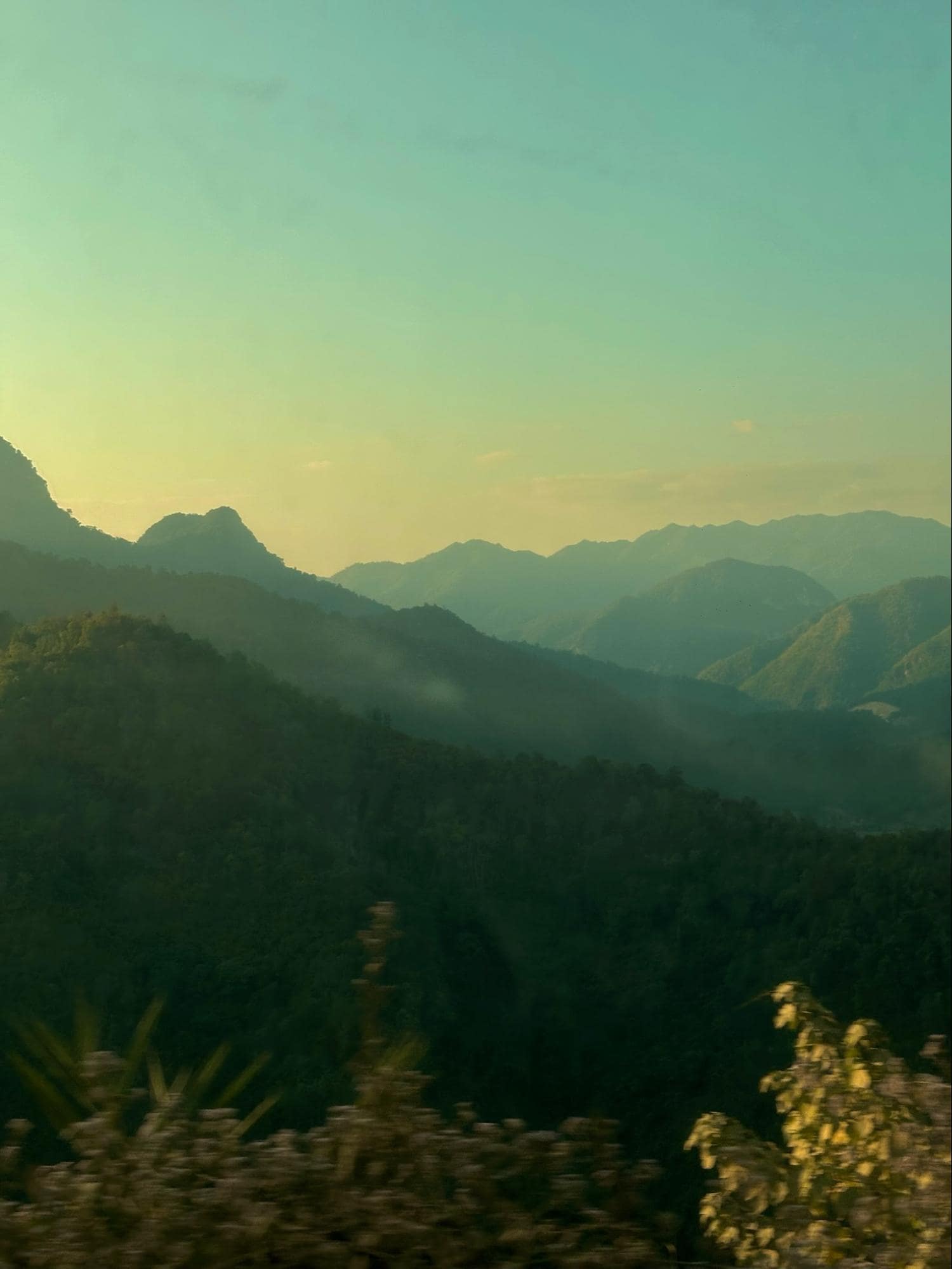
The mountain views made up for the bumpy ride.
Image credit: Billy Tran
Having read horror stories about the winding mountainous Laotian roads, we were prepared for the worst on this long bus ride. Experiencing it firsthand, the drive was surprisingly okay. Don’t get me wrong, you might still need to bring motion sickness pills because the bus was as bumpy as a rollercoaster. But the gorgeous mountain views and novelty of such an unconventional route with no other tourists in sight made it a lot more pleasant.
Up in the mountains was the Tay Trang Border Crossing Station, indicating that we had officially arrived in our fifth and final country on this trip. The immigration process was smooth and the border guards were friendly. Seeing my friends’ Singaporean passports, they couldn’t help but ask if we had watched Vietnam beat Singapore at football the night before.
Day 8: Dien Bien Phu to Moc Chau
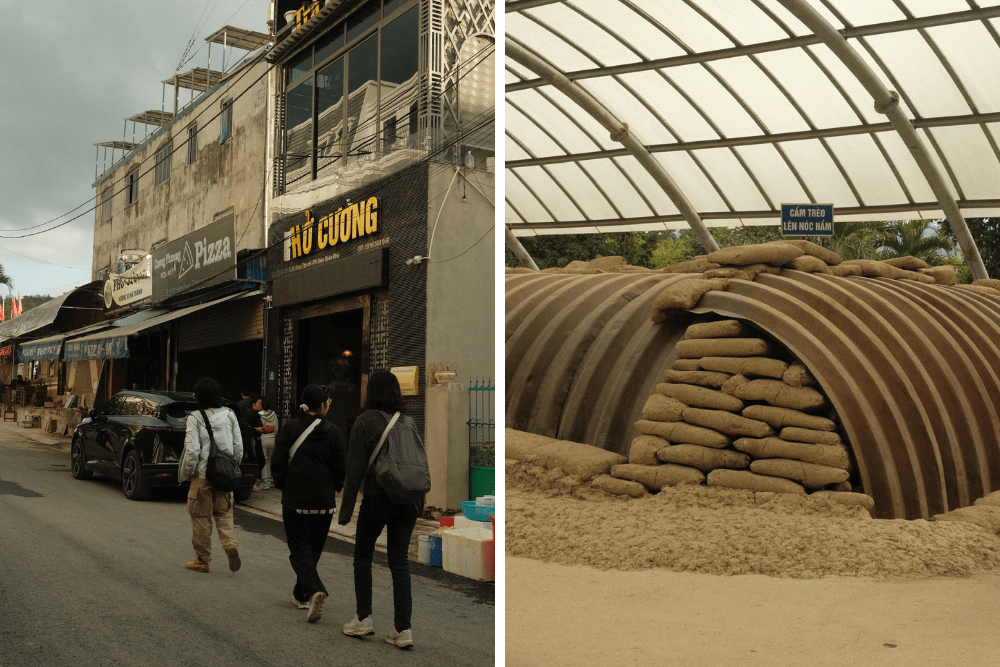
Finding breakfast in Dien Bien Phu and checking out the French Commander Bunker.
Image adapted from: Billy Tran
As it was winter in Northern Vietnam, we warmed up with a bowl of pho before our exploration for the day. Dien Bien Phu is best known for being the site of a decisive battle in 1954 where the Vietnamese defeated the French colonial power, regaining independence for Vietnam. Historical sites, monuments, and informational signages are scattered around the city, making it perfect for a self-guided walking tour.
We first visited Muong Thanh Bridge where Vietnamese troops crossed to launch their final offensive. A busy market is also located right at the foot of the bridge. The next stop was the French Commander Bunker, home to a famous photo in which soldiers mounted the bunker and waved the Vietnamese flag.
Almost everything you need to know about the Battle of Dien Bien Phu can be found in the Dien Bien Phu Victory Museum. Well laid out with informative displays and exhibitions, it is definitely worth spending a few hours inside. Plus, it features an impressive 360-degree panoramic painting depicting the decisive battle.
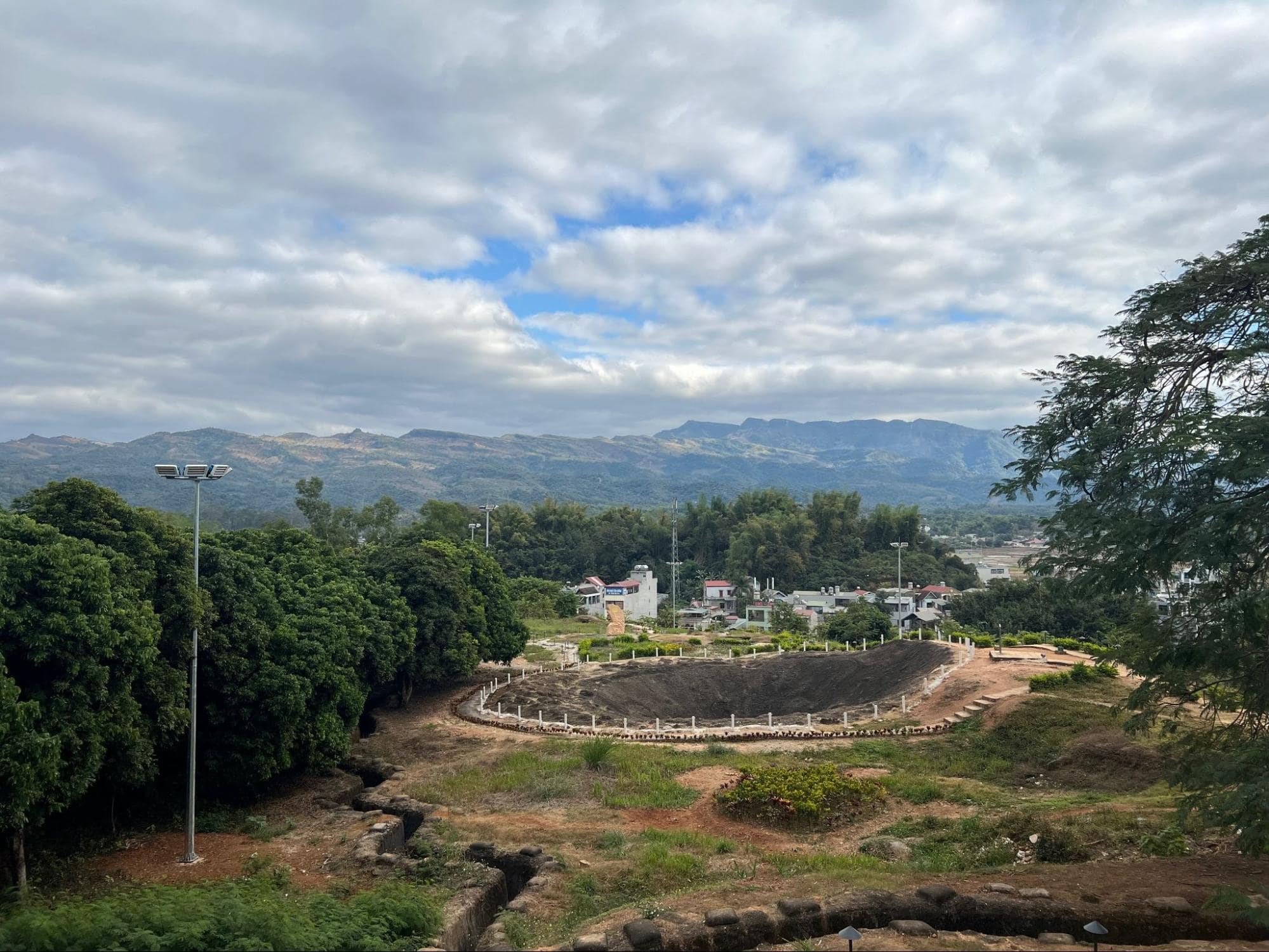
A massive crater was left behind on A1 Hill, with the Northern Vietnam mountain range in the background.
Image credit: Billy Tran
Rounding up our self-guided tour was A1 Hill, a former French fort and the site of bitter fighting for over a month. The hill overlooks large mountain ranges and has preserved bunkers, trenches, and a massive crater that are worthy of exploration.
This was the most history-heavy day on our trip and—combined with the museums we visited in Nong Khai, Vientiane, and Luang Prabang—gave us a much deeper appreciation for Southeast Asian history.
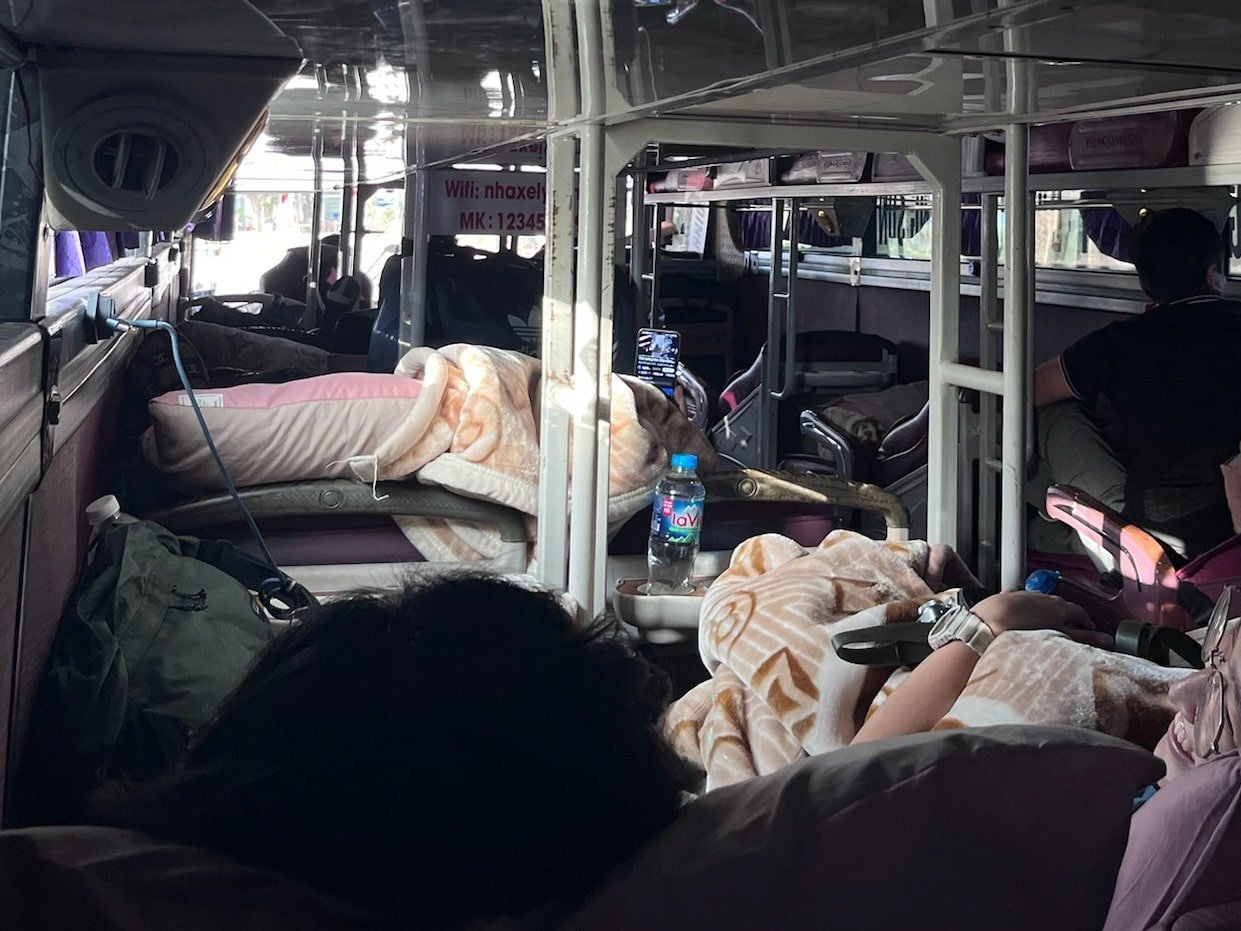
Sleeper bus from Dien Bien Phu to Moc Chau.
Image credit: Billy Tran
At 4pm we boarded our longest bus ride yet, an 8-hour sleeper bus from Dien Bien Phu to Moc Chau which cost us ~S$20 each. Tickets were booked online via Vexere, a bus ticketing platform for Vietnam. Thankfully we could lie down on the bus, but it is good to come tired and ready to take a nap. And fret not, there is a bathroom break and a pit stop for dinner in between.
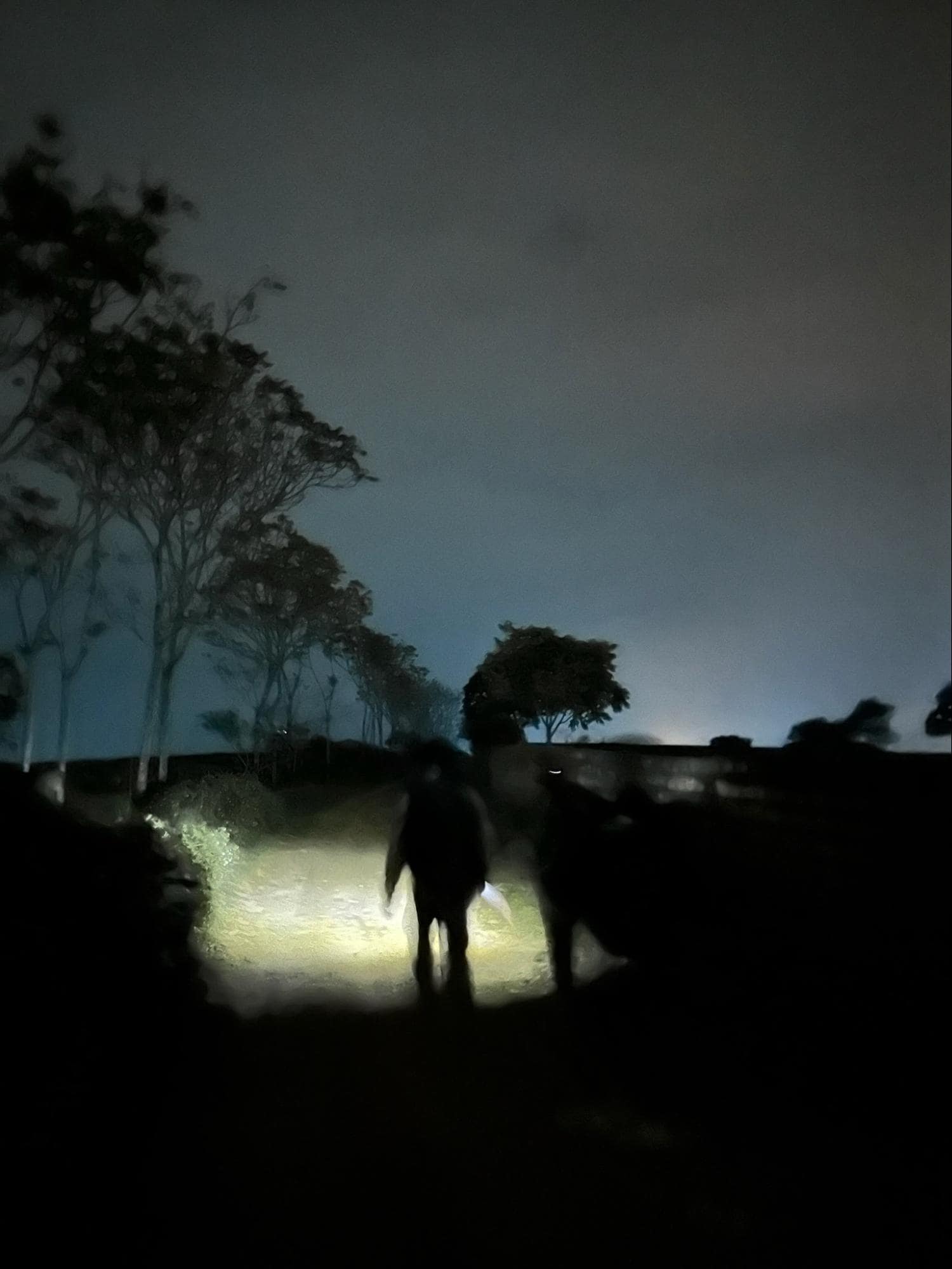
Finding our way to our Moc Chau homestay in the dark.
Image credit: Billy Tran
Since it couldn’t drive into the small roads, our sleeper bus dropped us off at midnight as close as it could to our homestay in Moc Chau. It was dark, and it was cold. Equipped with one headlamp and 3 phone flashlights, we briskly walked the 20 minutes to our accommodation.
Day 9: Moc Chau
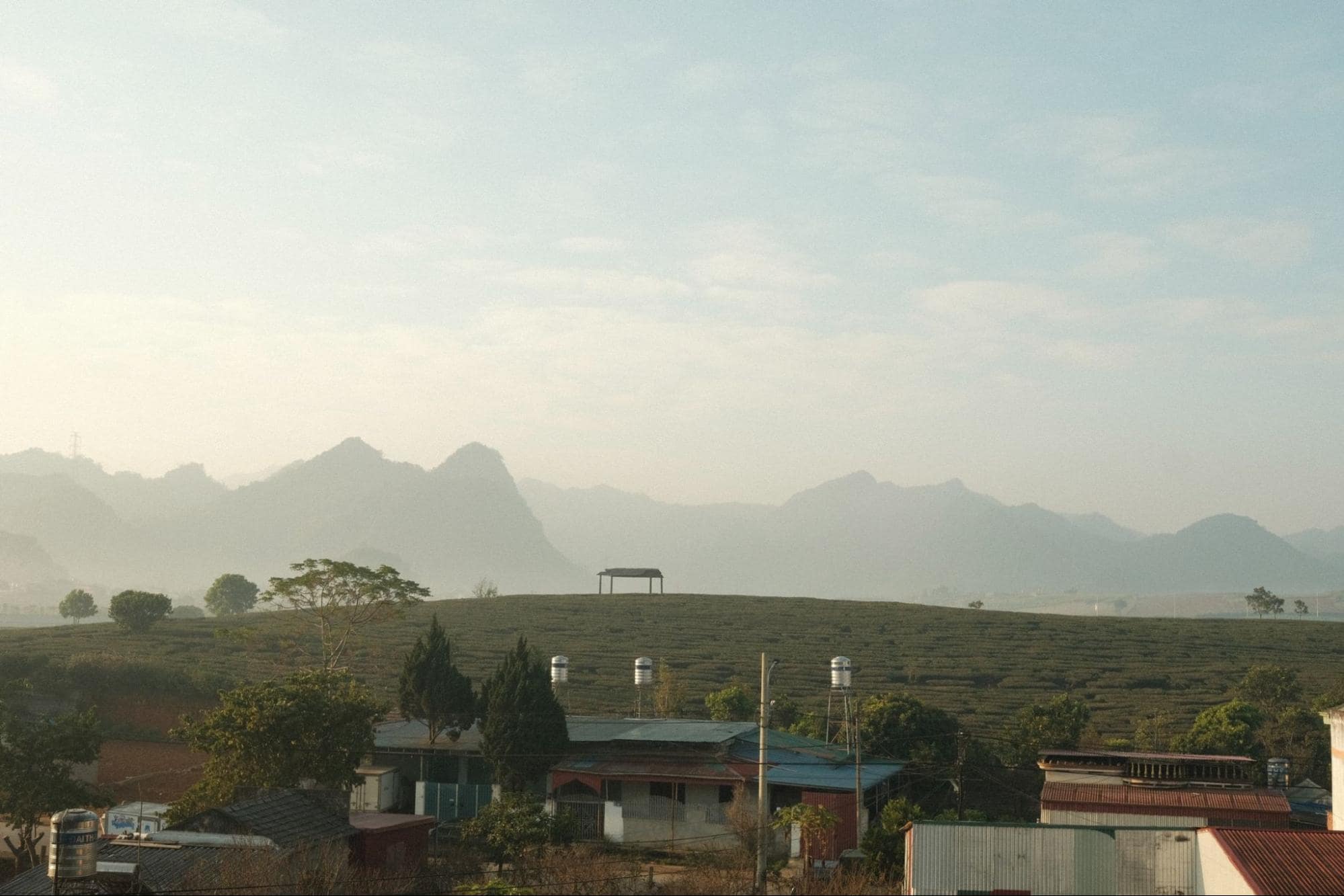
Morning in Moc Chau from our homestay window.
Image credit: Billy Tran
Moc Chau is a town nestled in a valley and surrounded by mountains, most famous for its idyllic tea plantations, flower gardens, and farms. We were greeted with the crisp cold of December, with temperatures ranging from 13-18 degrees Celcius during our stay. The real harbinger of cold was the wind, so jackets were certainly needed.
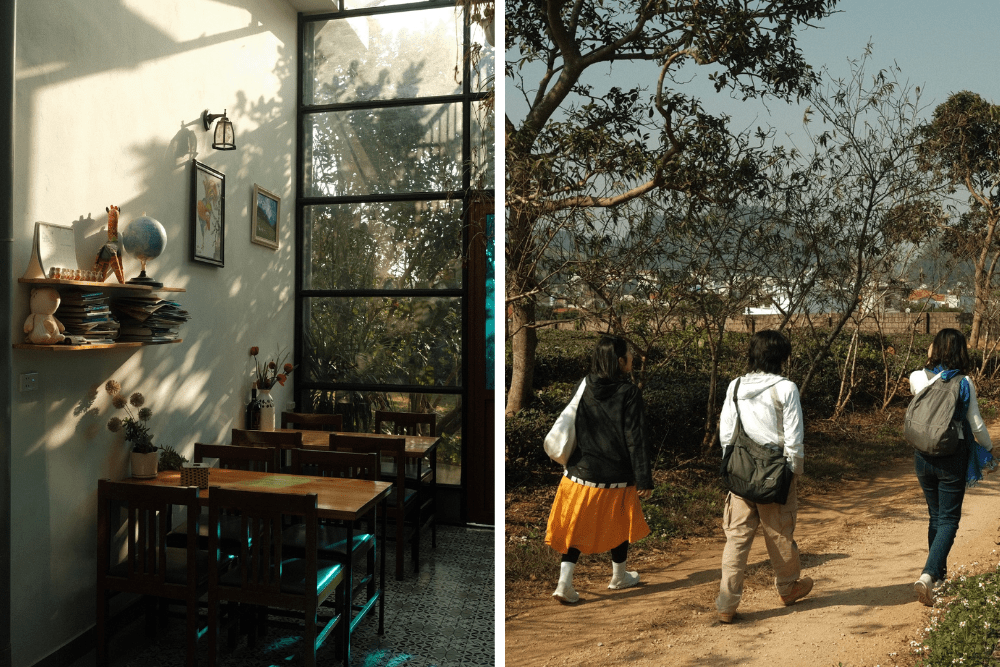
Moc Chau Cottage Homestay, where we slept for 2 nights.
Image adapted from: Billy Tran
The homestay we stayed at was effortlessly pretty and showcased the owner’s aesthetic taste. Let’s just say it took us a while to get out the door since we were happily taking photos in every corner.
To get around Moc Chau, we used a Vietnamese phone number that I already had to directly call taxi operators and book cabs. We were also happy with walking shorter distances and enjoying the weather. We didn’t have much luck with Grab or other ride-hailing apps since they hadn’t operated in the area. The best mode of transport would be to rent a motorbike or scooter, but make sure you have a proper license if you do.

Canh Cam Coffee and the picturesque views.
Image credit: Billy Tran
Relaxing and chilling at cafes are a Vietnamese pastime, so we headed to Canh Cam Coffee to soak in the picturesque views. Spacious with multiple seating options indoors and outdoors, the cafe would also be a great place to watch the sunset. For lunch, we headed to Bep Me Tinh which serves home-cooked food, but be early since food sells out fast.
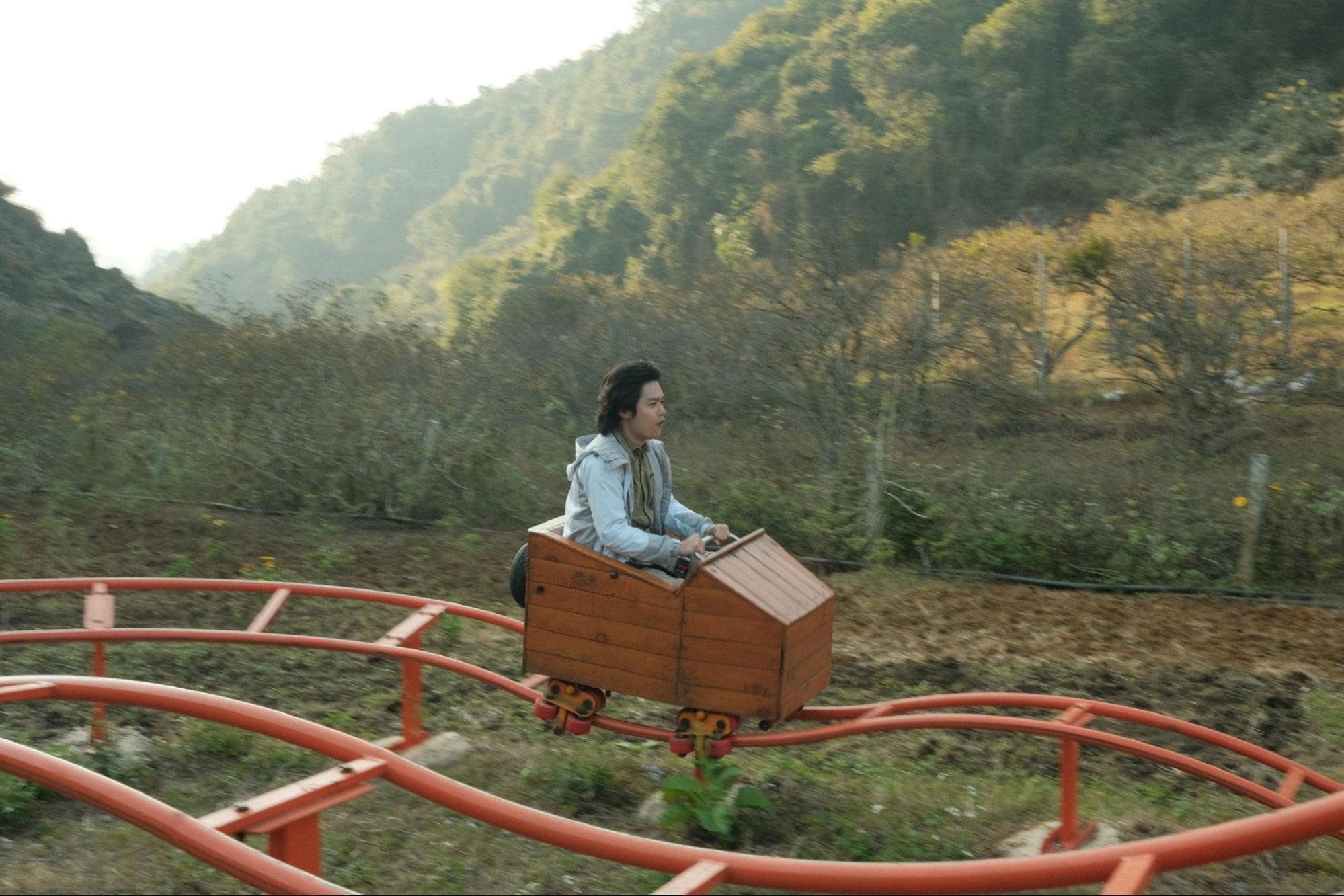
We rode this mini rollercoaster many times.
Image credit: Billy Tran
We spent the remaining daylight hours at Trai Hoa Vang, a farm on the outskirts of the town. You could play with the ponies, goats, alpacas, and a variety of dogs who lived on the farm. The best part was their DIY amusement park set-up which had a large swing, a 6-person see-saw, and a mini-roller coaster. We were entertained for hours.
Temperatures dropped greatly at night, so we cosied back into our homestay and watched the second leg of the ASEAN Football Championship semi-final with other guests in the common area. Everyone cheered as Vietnam once again beat Singapore to make it to the finals.
Day 10: Moc Chau to Hanoi

One last view of Moc Chau before we depart.
Image credit: Billy Tran
After enjoying one last view of the tea plantation outside our homestay, we had a quick breakfast and packed our bags to leave. Anticipation was building as, after 10 days on the road, the final destination was in sight.
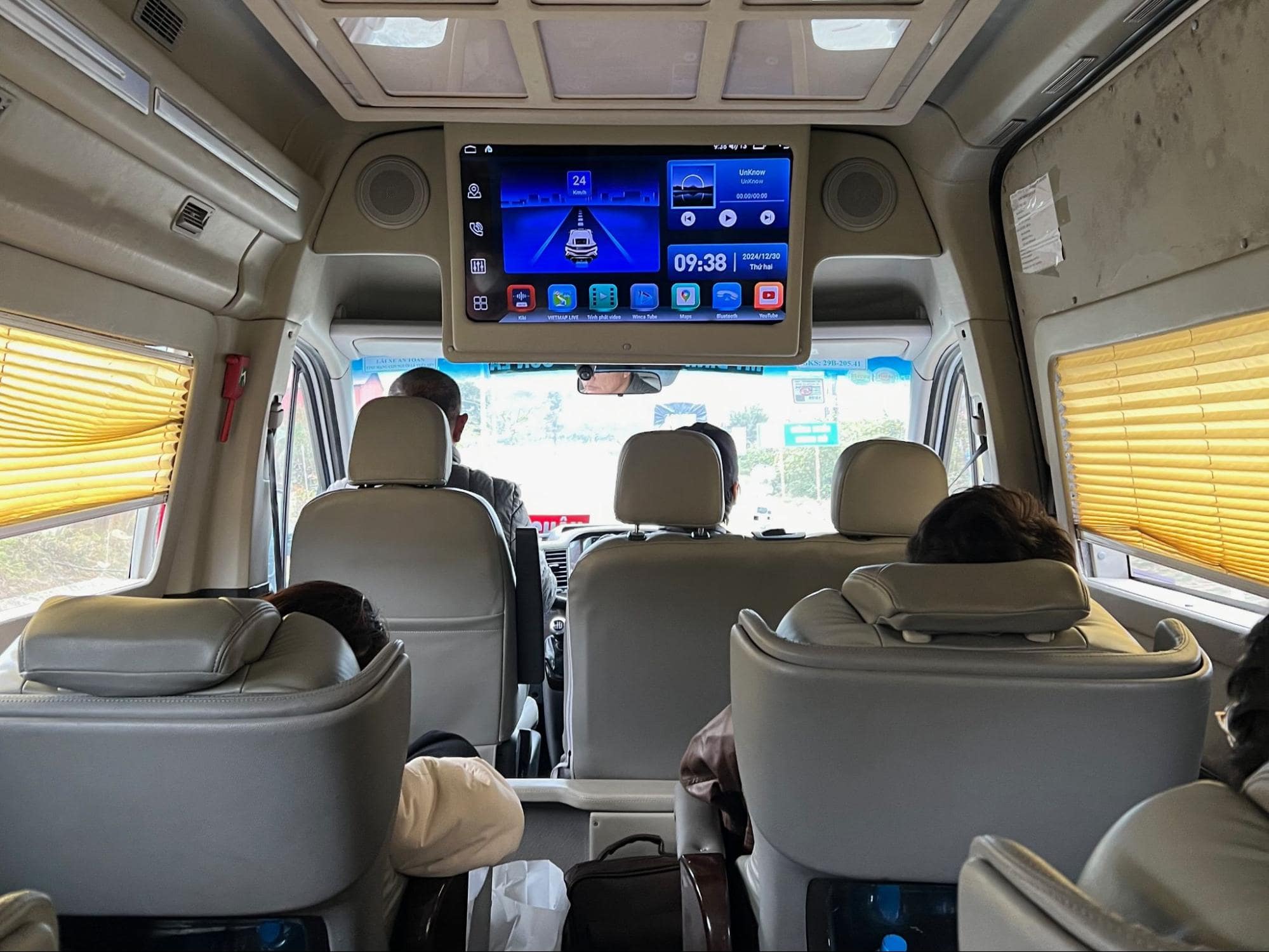
The van that drove us the final leg from Moc Chau to Hanoi.
Image credit: Billy Tran
A van, commonly known as a ‘limousine’ in Vietnam, picked us up at 9am to take the final 4-hour drive from Moc Chau to Hanoi. We also booked these tickets via Vexere for ~S$14 each. The closer we got to the city, the more surreal it felt.
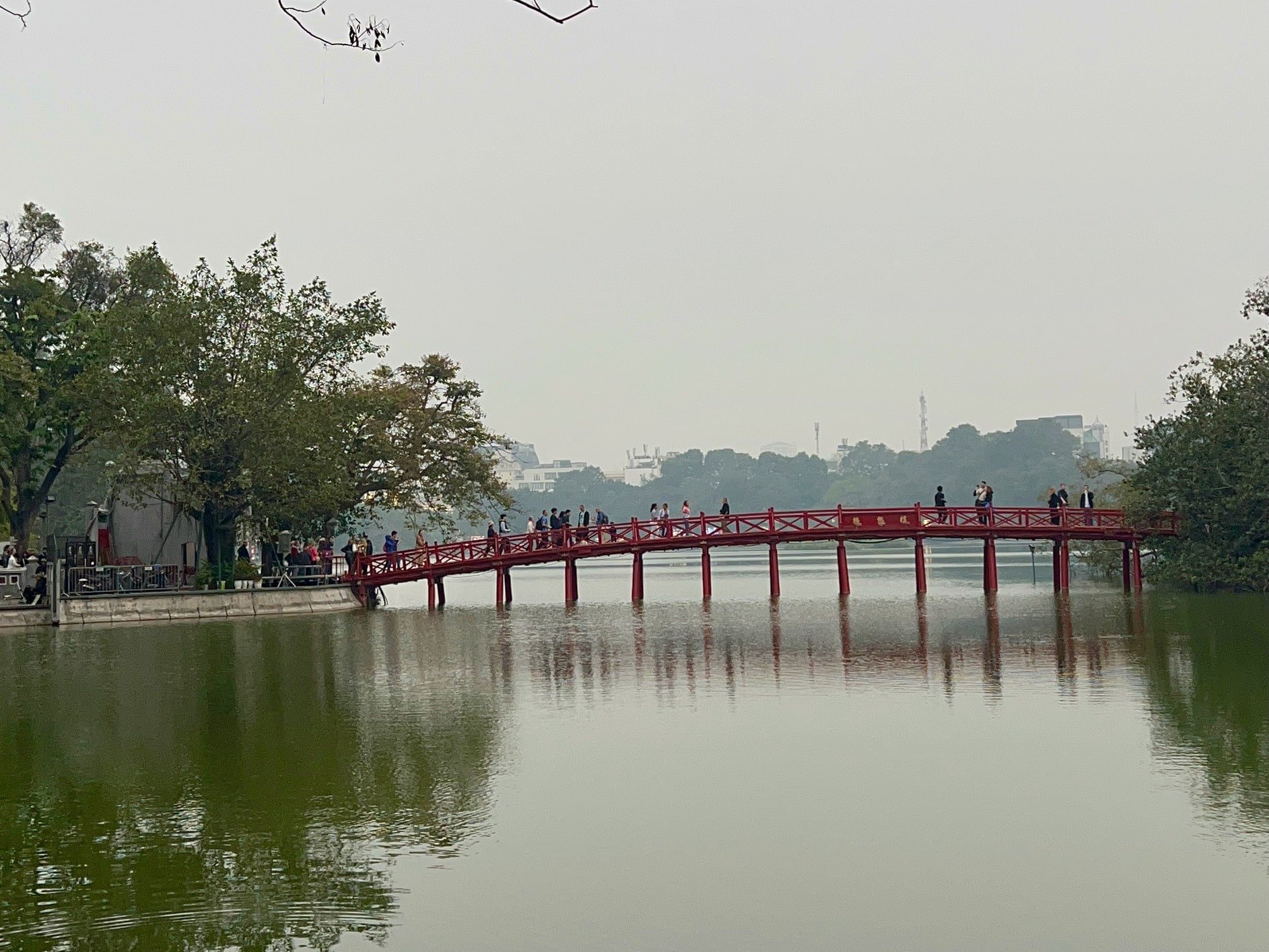
Image credit: Billy Tran
We reached Hanoi, the capital of Vietnam, at 1pm. I will never forget the mixture of excitement, satisfaction, and homecoming I felt when we arrived. A stroll around the iconic Hoan Kiem Lake made for a perfect introduction to, or reunion with, the city.
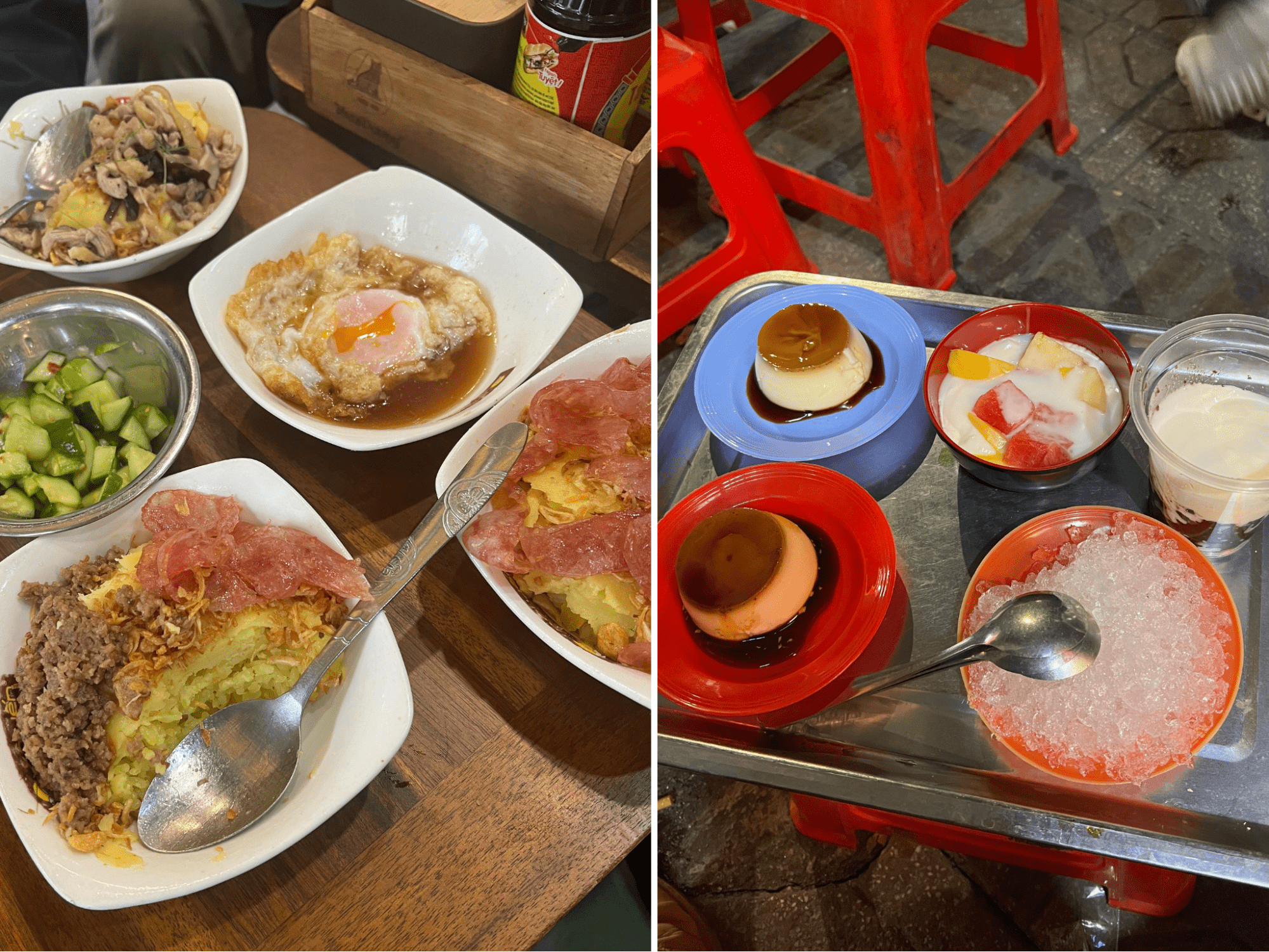
Eating in Hanoi is always a delight.
Image adapted from: Billy Tran
This time, it was my turn to introduce the group to Hanoi’s food scene and places I’d been eating at since I was a kid. We had an early dinner at Xoi Yen, a popular spot for sticky rice with customisable toppings including mung beans, pate, braised pork, shredded chicken, eggs, and fried shallots. Then, for dessert, we visited the streetside Kem Caramen Duong Hoa, well-known for its flan but also has yoghurt, ice cream, and other treats on the menu.
Finally, we made it from Singapore to Hanoi. A bittersweet feeling, I was happy to have reached our destination but sad that the journey was over. Reflecting on the trip as night fell, I was grateful that I could embark on this trip and have my friends along for the ride.
Epilogue: Hanoi
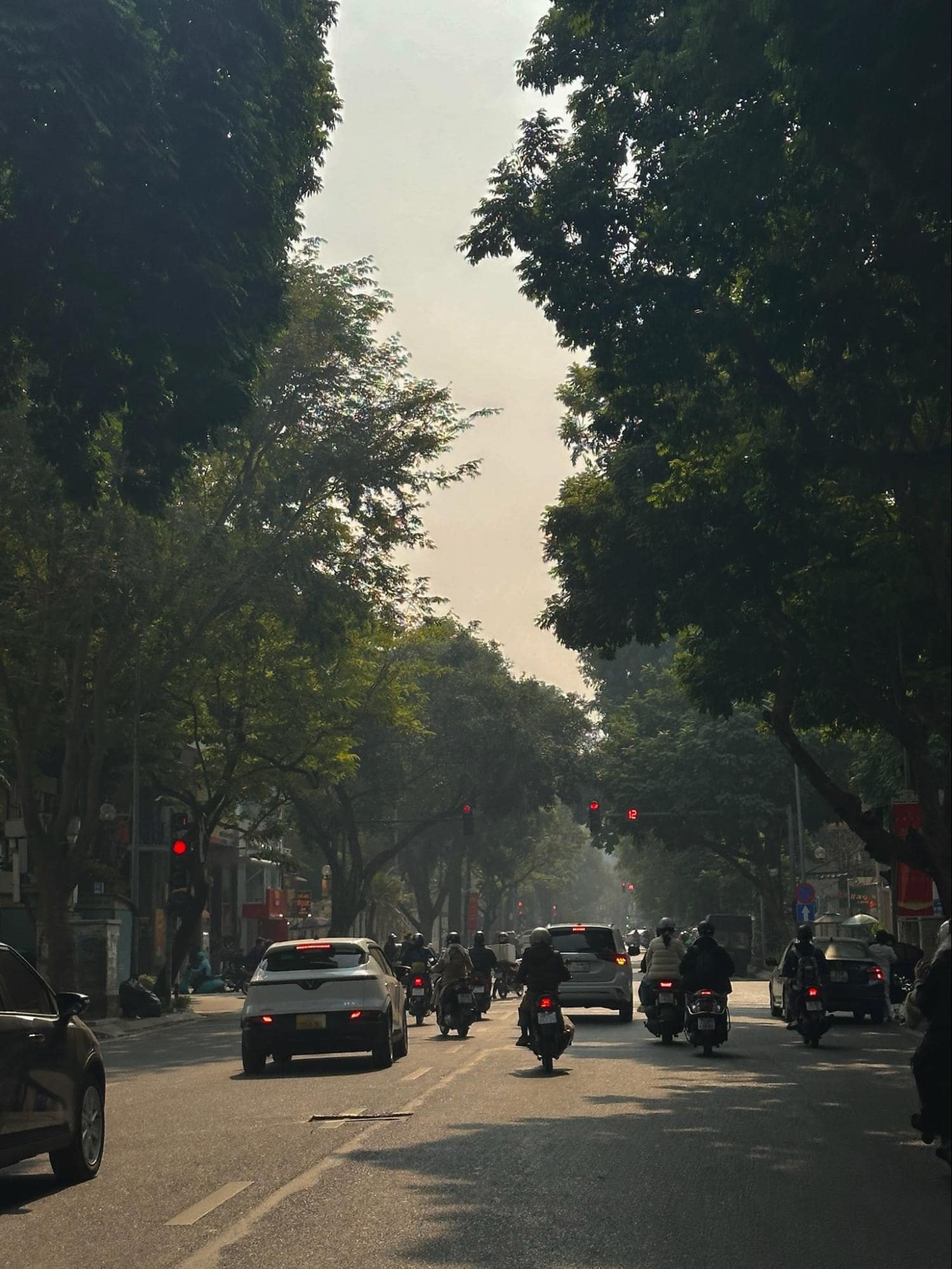
The streets of Hanoi.
Image credit: Billy Tran
The group and I stayed in Hanoi for the next few days to slowly enjoy the city and recuperate after our overland expedition. We slowly visited the city’s major attractions such as the Temple of Literature, Hoa Lo Prison, Ba Dinh Square, and Old Quarter. Hanoi has a timeless charm and romantic vibe, perfectly blending culture, history, and big-city busyness.

Bun cha is a Hanoi speciality and one of my favourite dishes in the world.
Image credit: Billy Tran
I also brought my friends to eat bun cha, charcoal grilled pork served with rice vermicelli noodles and dipping sauce made from fish sauce, vinegar, sugar, and more. The dish is a Hanoi speciality and, in my totally unbiased opinion, quite possibly the best food to ever exist.
Of course, we also enjoyed pho, egg coffee, and banh mi to round up the Hanoi food tour. And though it may sound unusual, I would highly recommend a visit to Pizza 4P’s, a Vietnam-based Japanese-Italian fusion restaurant with a unique, high-quality menu.

Vietnamese people take football celebrations very seriously.
Image credit: Billy Tran
Last but not least, remember the ASEAN Football Championship? On our last day in Hanoi and Day 13 of the trip, Vietnam beat Thailand in the first leg of the final. We joined as people flooded the streets in celebration, waving flags and cheering in jubilation. The victory celebrations lasted throughout the night and were a fitting end to our journey.
Frequently asked questions
Is there more than one route?
Yes! This journey is entirely customisable depending on your interests and how much time you have. For example, you could go from Thailand to Cambodia to Vietnam instead of via Laos. If there’s a city along the way that you’re interested in, you can choose to spend more time there as well.
Do I need a visa for the land borders?
It depends on your passport, so you’ll have to check accordingly. ASEAN passport holders, which include Singaporeans, can travel to all other ASEAN countries visa-free. However, double-check before you go as rules may change. For example, during our trip, Myanmar passport holders were not allowed to cross land borders in or out of Thailand.
Do I need to bring cash?
It is advisable since cash is still king in most of the places we visited. Convert the currencies you can before you leave, but bring some extra SGD or USD since Laotian Kip and Cambodian Riel can only be converted in the country.
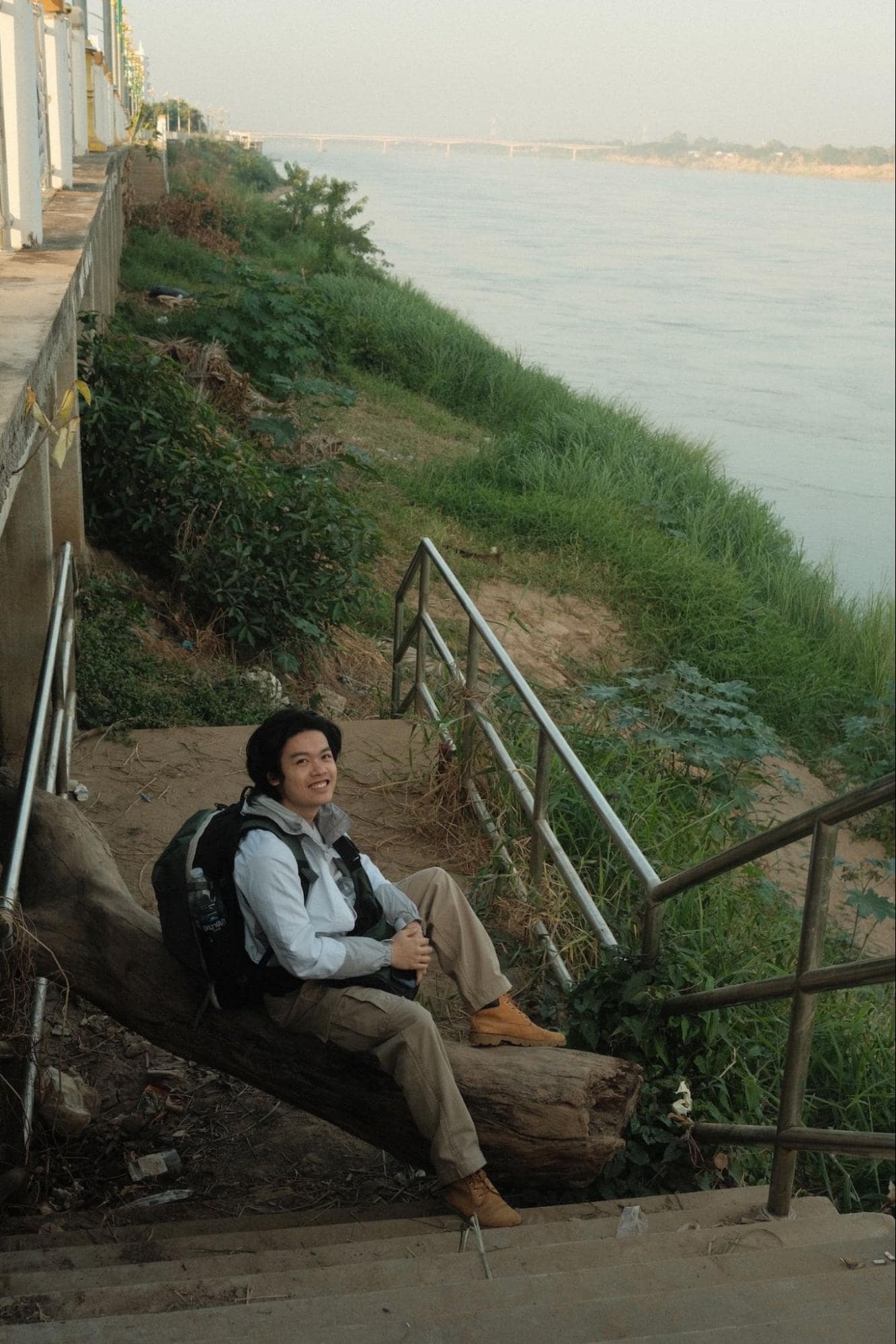
Image credit: Billy Tran
Is it safe to go on this trip solo?
Generally, yes. The train and bus routes we took were fairly common and had many tourists. Plus, the cities and towns we visited were fairly big and well-known. Of course, do decide based on your comfort level and exercise the standard precautions.
What do I need to pack?
Your usual packing list for any other trip should suffice, but try to pack light since you’ll be doing a lot of moving around. Our group only had a 35-40L backpack each. Check the weather as well, we went in December so we needed to pack a few winter clothes as it gets cold in Northern Thailand, Laos, and Vietnam. Specific items useful for this sort of adventure include entertainment for long rides, motion sickness pills, washing powder for laundry, comfortable walking shoes, and a foldable day pack.
Covering 5 countries when travelling overland from Singapore to Hanoi
It was a privilege to be able to experience the diversity of cultures, environments, foods, and cityscapes that Southeast Asia had to offer on this journey. From the wealthy Singapore to the sprawling Bangkok to the tranquil Moc Chau, each place I visited expanded my perspectives on life.
Though physical land borders exist between these countries, the region is still highly interconnected. It was interesting to see what influences seeped through the borders and what was blocked by these man-made barriers. I had a great time connecting the dots and uncovering the shared history between different regions.
The trip also illuminated to me that visa-free travel within the ASEAN region is so valuable, especially for someone holding a relatively weak Vietnamese passport. With more rail infrastructure being developed in the region, it’ll be exciting to see what the future holds.
Would I recommend this trip? Absolutely. It may seem daunting at first, but the clear train and bus routes between well-known cities make this itinerary surprisingly doable even if you’re not a frequent backpacker. And remember, it’s not about the destination, it’s the journey.
I’m already planning part 2. Who knows, maybe I’ll go all the way overland to Europe.
Cover image adapted from: Billy Tran
